Endo-polysaccharide of Phellinus igniarius exhibited anti-tumor effect through enhancement of cell
- 格式:pdf
- 大小:364.25 KB
- 文档页数:5
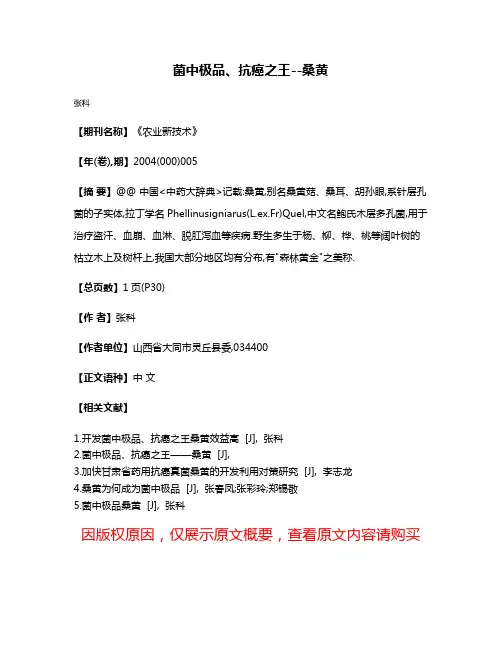
菌中极品、抗癌之王--桑黄
张科
【期刊名称】《农业新技术》
【年(卷),期】2004(000)005
【摘要】@@ 中国<中药大辞典>记载:桑黄,别名桑黄菇、桑耳、胡孙眼,系针层孔菌的子实体,拉丁学名Phellinusigniarus(L.ex.Fr)Quel,中文名鲍氏木层多孔菌,用于治疗盗汗、血崩、血淋、脱肛泻血等疾病.野生多生于杨、柳、桦、桃等阔叶树的枯立木上及树杆上,我国大部分地区均有分布,有"森林黄金"之美称.
【总页数】1页(P30)
【作者】张科
【作者单位】山西省大同市灵丘县委,034400
【正文语种】中文
【相关文献】
1.开发菌中极品、抗癌之王桑黄效益高 [J], 张科
2.菌中极品、抗癌之王——桑黄 [J],
3.加快甘肃省药用抗癌真菌桑黄的开发利用对策研究 [J], 李志龙
4.桑黄为何成为菌中极品 [J], 张春凤;张彩玲;郑锡敬
5.菌中极品桑黄 [J], 张科
因版权原因,仅展示原文概要,查看原文内容请购买。
![稠环双阳离子抗原生动物药物及其前药[发明专利]](https://uimg.taocdn.com/3683ba3250e2524de4187e80.webp)
专利名称:稠环双阳离子抗原生动物药物及其前药
专利类型:发明专利
发明人:戴维·W.·博伊金,理查德·R.·蒂德韦尔,戴维·W.·威尔逊,雷托·布伦,雷姆·K.·阿拉法,查德·E.·斯蒂芬斯
申请号:CN200480034750.5
申请日:20041118
公开号:CN1886367A
公开日:
20061227
专利内容由知识产权出版社提供
摘要:本发明涉及新型稠环双阳离子抗原生动物化合物。
代表性的原生动物包括但不局限于布氏罗得西亚锥虫(T.b.r.)和疟原虫。
这些化合物的前药可以用作疟疾和非洲人类锥虫病口服治疗药物。
申请人:北卡罗来纳大学查珀尔希尔分校,佐治亚州立大学研究基金会公司
地址:美国北卡罗来纳
国籍:US
代理机构:永新专利商标代理有限公司
代理人:过晓东
更多信息请下载全文后查看。
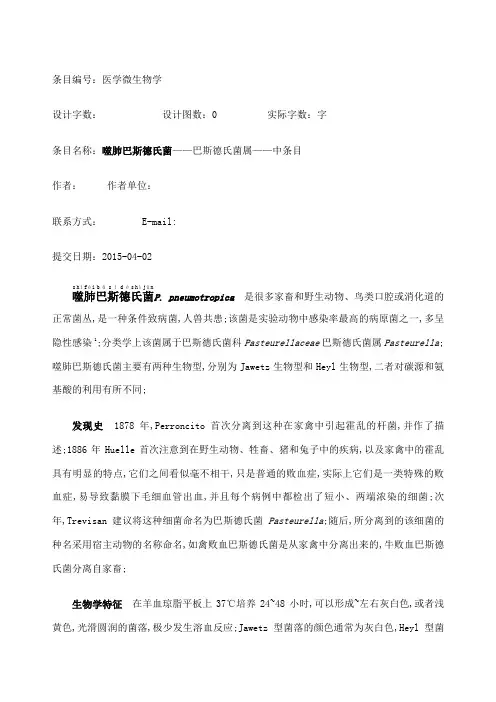
条目编号:医学微生物学设计字数:设计图数:0 实际字数:字条目名称:噬肺巴斯德氏菌——巴斯德氏菌属——中条目作者:作者单位:联系方式: E-mail:提交日期:2015-04-02噬s hì肺fèi巴bā斯sī德dé氏s hì菌jūn P. pneumotropica是很多家畜和野生动物、鸟类口腔或消化道的正常菌丛,是一种条件致病菌,人兽共患;该菌是实验动物中感染率最高的病原菌之一,多呈隐性感染1;分类学上该菌属于巴斯德氏菌科Pasteurellaceae巴斯德氏菌属Pasteurella;噬肺巴斯德氏菌主要有两种生物型,分别为Jawetz生物型和Heyl生物型,二者对碳源和氨基酸的利用有所不同;发现史1878年,Perroncito首次分离到这种在家禽中引起霍乱的杆菌,并作了描述;1886年Huelle首次注意到在野生动物、牲畜、猪和兔子中的疾病,以及家禽中的霍乱具有明显的特点,它们之间看似毫不相干,只是普通的败血症,实际上它们是一类特殊的败血症,易导致黏膜下毛细血管出血,并且每个病例中都检出了短小、两端浓染的细菌;次年,Trevisan建议将这种细菌命名为巴斯德氏菌Pasteurella;随后,所分离到的该细菌的种名采用宿主动物的名称命名,如禽败血巴斯德氏菌是从家禽中分离出来的,牛败血巴斯德氏菌分离自家畜;生物学特征在羊血琼脂平板上37℃培养24~48小时,可以形成~左右灰白色,或者浅黄色,光滑圆润的菌落,极少发生溶血反应;Jawetz型菌落的颜色通常为灰白色,Heyl型菌落的颜色则通常为黄色;大多数菌株在麦康凯琼脂上培养48小时不生长; 镜下见革兰氏阴性杆菌,呈两级浓染,形态不规则,无芽孢、无荚膜;致病性噬肺巴斯德氏菌作为条件致病菌,分布广泛,主要感染啮齿类动物,对实验动物中小鼠、大鼠和豚鼠的危害较大;在国内外的实验动物中,噬肺巴斯德氏菌是目前感染率最高的病原菌之一;噬肺巴斯德氏菌也是人兽共患病原,人感染此菌多数情况是接触了带菌宠物,被咬伤、抓伤后受到感染;不同年龄和性别的人均可感染,能引起免疫缺陷动物或免疫功能低下者发病,引起人的局部和全身感染,包括关节炎、脓肿,严重者可发热、盗汗、明显消瘦和菌血症,还可造成手术部位红肿,造成院内感染;免疫特征噬肺巴斯德氏菌在免疫功能正常的动物中一般呈隐性感染, 不表现出任何的临床症状;小鼠在感染噬肺巴斯德氏菌后的第2天,肺中的T淋巴细胞CD4+和CD8+、自然杀伤细胞 CD49bDX5和巨噬细胞F4/80+明显增多;而在感染后一周,这些细胞的又会恢复到正常范围;MHC II,Tlr4和Nrampl三个基因在小鼠肺部免疫中起着重要的作用,参与免疫的重要性程度为 MHC II= Tlr4>Nrampl;缺乏这三种基因的小鼠对噬肺巴斯德氏菌更加易感;其中Tlr4对防止噬肺巴斯德氏菌感染具至关重要的作用;跨膜受体Tlr4有助于巨噬细胞在感染早期对噬肺巴斯德氏菌进行识别和清除,即使是缺乏CD4+T细胞,也可以实现对机体的保护;实验室检测其表型和基因特征与放线菌属相似,不同的菌株在吲哚和鸟氨酸脱羧酶的产生有所不同,不发酵甘露醇;另外菌株对NAD的依赖性也可以作为噬肺巴斯德氏菌的鉴定指标;血清凝集试验是检测噬肺巴斯德氏菌的一项重要参考项目; 凝集试验所用阳性血清是由全菌抗原免疫相应动物获得的;基于两种生物型的差异,可疑菌株需要用生物型Jawetz和Heyl两种免疫血清分别进行检测;由于全菌抗原极易发生交叉反应,国内已有研究用脂多糖LPS和外膜蛋白OMP作为免疫抗原,具有更好的抗原特异性和敏感性;在实际检测过程中,经常会遇到分离培养和血清凝集试验不能完成对噬肺巴斯德氏菌的有效检测,这时还需要采用PCR方法进行验证;相关疾病防治原则噬肺巴斯德氏菌对一至四代头孢菌素类抗生素及四环素、哌拉西林、复方新诺明、阿米卡星、庆大霉素、妥布霉素、青霉素等各类抗生素均敏感;通过药敏试验表明大部分噬肺巴斯德氏菌株对恩氟沙星敏感,用恩氟沙星经由饮水长期饲喂小鼠,可以有效去除小鼠种群中噬肺巴斯德氏菌;在各种环境因素中,饮水、饲料、垫料和换气次数等是主要应该控制的项目; 室温下20~25℃,PP在PBS中最长可存活6天,在蒸馏水和自来水中只能存活3天;在饲料、垫料中,PP的污染几率也很小,即便是纯培养的PP菌落,血琼脂培养基上存活也不会超过一周; 饮水、饲料和垫料的污染并不是实验动物感染PP的主要原因;到目前为止,国内尚嗜肺巴斯德杆菌感染人的报道十分罕见;但根据实验动物微生物监测的结果可推测,该菌在我国环境中同样广泛存在; 由于流浪猫、犬的大量存在,以及饲养各种动物作为宠物的人越来越多,该菌的暴露人群的基数是非常庞大的;这些动物都可能作为该菌的中间宿主,通过抓咬感染人,因此应该引起我们足够的重视;索引词参考文献1 范薇, 贺争鸣. 普通级啮齿类实验动物部分细菌携带情况的初步调查J. 实验动物科学与管理, 2001, 182: 18-20.2 邢进, 冯育芳, 岳秉飞, 等. 嗜肺巴斯德杆菌研究进展J. 中国实验动物学报, 2014, 222: 90-94.3 祝慧华. 从痰液中分离出 1 株侵肺巴斯德菌J. 临床检验杂志, 2006, 242: 130-130.。
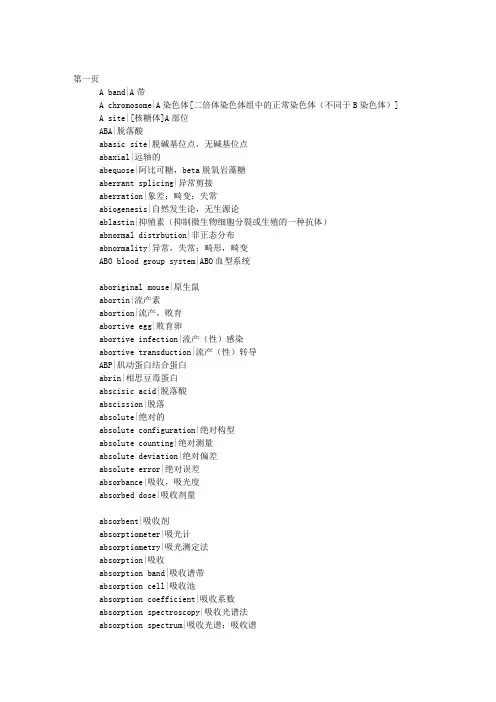
第一页A band|A带A chromosome|A染色体[二倍体染色体组中的正常染色体(不同于B染色体)] A site|[核糖体]A部位ABA|脱落酸abasic site|脱碱基位点,无碱基位点abaxial|远轴的abequose|阿比可糖,beta脱氧岩藻糖aberrant splicing|异常剪接aberration|象差;畸变;失常abiogenesis|自然发生论,无生源论ablastin|抑殖素(抑制微生物细胞分裂或生殖的一种抗体)abnormal distrbution|非正态分布abnormality|异常,失常;畸形,畸变ABO blood group system|ABO血型系统aboriginal mouse|原生鼠abortin|流产素abortion|流产,败育abortive egg|败育卵abortive infection|流产(性)感染abortive transduction|流产(性)转导ABP|肌动蛋白结合蛋白abrin|相思豆毒蛋白abscisic acid|脱落酸abscission|脱落absolute|绝对的absolute configuration|绝对构型absolute counting|绝对测量absolute deviation|绝对偏差absolute error|绝对误差absorbance|吸收,吸光度absorbed dose|吸收剂量absorbent|吸收剂absorptiometer|吸光计absorptiometry|吸光测定法absorption|吸收absorption band|吸收谱带absorption cell|吸收池absorption coefficient|吸收系数absorption spectroscopy|吸收光谱法absorption spectrum|吸收光谱;吸收谱absorptive endocytosis|吸收(型)胞吞(作用) absorptive pinocytosis|吸收(型)胞饮(作用) absorptivity|吸光系数;吸收性abundance|丰度abundant|丰富的,高丰度的abundant mRNAs|高丰度mRNAabzyme|抗体酶acaricidin|杀螨剂accedent variation|偶然变异accelerated flow method|加速流动法accepting arm|[tRNA的]接纳臂acceptor|接纳体,(接)受体acceptor site|接纳位点,接受位点acceptor splicing site|剪接受体acceptor stem|[tRNA的]接纳茎accessible|可及的accessible promoter|可及启动子accessible surface|可及表面accessory|零件,附件;辅助的accessory cell|佐细胞accessory chromosome|副染色体accessory factor|辅助因子accessory nucleus|副核accessory pigment|辅助色素accessory protein|辅助蛋白(质)accommodation|顺应accumulation|积累,累积accuracy|准确度acenaphthene|二氢苊acene|并苯acentric|无着丝粒的acentric fragment|无着丝粒断片acentric ring|无着丝粒环acetal|缩醛acetaldehyde|乙醛acetalresin|缩醛树脂acetamidase|乙酰胺酶acetamide|乙酰胺acetate|乙酸盐acetic acid|乙酸,醋酸acetic acid bacteria|乙酸菌,醋酸菌acetic anhydride|乙酸酐acetification|乙酸化作用,醋化作用acetin|乙酸甘油酯,三乙酰甘油酯acetoacetic acid|乙酰乙酸Acetobacter|醋杆菌属acetogen|产乙酸菌acetogenic bacteria|产乙酸菌acetome body|酮体acetome powder|丙酮制粉[在-30度以下加丙酮制成的蛋白质匀浆物] acetomitrile|乙腈acetone|丙酮acetyl|乙酰基acetyl coenzyme A|乙酰辅酶Aacetylcholine|乙酰胆碱acetylcholine agonist|乙酰胆碱拮抗剂acetylcholine receptor|乙酰胆碱受体acetylcholinesterase|乙酰胆碱酯酶acetylene|乙炔acetylene reduction test|乙炔还原试验[检查生物体的固氮能力] acetylglucosaminidase|乙酰葡糖胺糖苷酶acetylglutamate synthetase|乙酰谷氨酸合成酶acetylsalicylate|乙酰水杨酸;乙酰水杨酸盐、酯、根acetylsalicylic acid|乙酰水杨酸acetylspiramycin|乙酰螺旋霉素AchE|乙酰胆碱酯酶achiral|非手性的acholeplasma|无胆甾原体AchR|乙酰胆碱受体achromatic|消色的;消色差的achromatic color|无色achromatic lens|消色差透镜achromatin|非染色质acid catalysis|酸催化acid fibroblast growth factor|酸性成纤维细胞生长因子acid fuchsin|酸性品红acid glycoprotein|酸性糖蛋白acid hydrolyzed casein|酸水解酪蛋白acid medium|酸性培养基acid mucopolysaccharide|酸性粘多糖acid phosphatase|酸性磷酸酶acid protease|酸性蛋白酶acid solvent|酸性溶剂acidic|酸性的acidic amino acid|酸性氨基酸acidic protein|酸性蛋白质[有时特指非组蛋白]acidic transactivator|酸性反式激活蛋白acidic transcription activator|酸性转录激活蛋白 acidification|酸化(作用)acidifying|酸化(作用)acidolysis|酸解acidophilia|嗜酸性acidophilic bacteria|嗜酸菌acidophilous milk|酸奶aclacinomycin|阿克拉霉素acoelomata|无体腔动物acomitic acid|乌头酸aconitase|顺乌头酸酶aconitate|乌头酸;乌头酸盐、酯、根aconitine|乌头碱aconitum alkaloid|乌头属生物碱ACP|酰基载体蛋白acquired character|获得性状acquired immunity|获得性免疫acridine|吖啶acridine alkaloid|吖啶(类)生物碱acridine dye|吖啶燃料acridine orange|吖啶橙acridine yellow|吖啶黄acriflavine|吖啶黄素acroblast|原顶体acrocentric chromosome|近端着丝染色体acrolein|丙烯醛acrolein polymer|丙烯醛类聚合物acrolein resin|丙烯醛树脂acropetal translocation|向顶运输acrosin|顶体蛋白acrosomal protease|顶体蛋白酶acrosomal reaction|顶体反应acrosome|顶体acrosome reaction|顶体反应acrosomic granule|原顶体acrosyndesis|端部联会acrylamide|丙烯酰胺acrylate|丙烯酸酯、盐acrylic acid|丙烯酸acrylic polymer|丙烯酸(酯)类聚合物acrylic resin|丙烯酸(酯)类树脂acrylketone|丙烯酮acrylonitrile|丙烯腈actidione|放线(菌)酮[即环己酰亚胺]actin|肌动蛋白actin filament|肌动蛋白丝actinin|辅肌动蛋白[分为alfa、beta两种,beta蛋白即加帽蛋白] actinmicrofilament|肌动蛋白微丝actinometer|化学光度计actinomorphy|辐射对称[用于描述植物的花]actinomycetes|放线菌actinomycin D|放线菌素Dactinospectacin|放线壮观素,壮观霉素,奇霉素action|作用action current|动作电流action potential|动作电位action spectrum|动作光谱activated sludge|活性污泥activated support|活化支持体activating group|活化基团activating transcription factor|转录激活因子activation|激活;活化activation analysis|活化分析activation energy|活化能activator|激活物,激活剂,激活蛋白activator protein|激活蛋白active absorption|主动吸收active biomass|活生物质active carbon|活性碳active center|活性中心active chromatin|活性染色质active dry yeast|活性干酵母active dydrogen compounds|活性氢化合物active ester of amino acid|氨基酸的活化酯active hydrogen|活性氢active immunity|主动免疫active oxygen|活性氧active site|活性部位,活性中心active transport|主动转运active uptake|主动吸收activin|活化素[由垂体合成并由睾丸和卵巢分泌的性激素]activity|活性,活度,(放射性)活度actomyosin|肌动球蛋白actophorin|载肌动蛋白[一种肌动蛋白结合蛋白]acute|急性的acute infection|急性感染acute phase|急性期acute phase protein|急性期蛋白,急相蛋白acute phase reaction|急性期反应,急相反应[炎症反应急性期机体的防御反应] acute phase reactive protein|急性期反应蛋白,急相反应蛋白acute phase response|急性期反应,急相反应acute toxicity|急性毒性ACV|无环鸟苷acyclic nucleotide|无环核苷酸acycloguanosine|无环鸟苷,9-(2-羟乙氧甲基)鸟嘌呤acyclovir|无环鸟苷acyl|酰基acyl carrier protein|酰基载体蛋白acyl cation|酰(基)正离子acyl chloride|酰氯acyl CoA|脂酰辅酶Aacyl coenzyem A|脂酰辅酶Aacyl fluoride|酰氟acyl halide|酰卤acylamino acid|酰基氨基酸acylase|酰基转移酶acylating agent|酰化剂acylation|酰化acylazide|酰叠氮acylbromide|酰溴acyloin|偶姻acyltransferase|酰基转移酶adamantanamine|金刚烷胺[曾用作抗病毒剂]adamantane|金刚烷adaptability|适应性adaptation|适应adapter|衔接头;衔接子adapter protein|衔接蛋白质adaptin|衔接蛋白[衔接网格蛋白与其他蛋白的胞质区]adaptive behavior|适应性行为adaptive enzyme|适应酶adaptive molecule|衔接分子adaptive response|适应反应[大肠杆菌中的DNA修复系统]adaptor|衔接头;衔接子adaxial|近轴的addition|加成addition compound|加成化合物addition haploid|附加单倍体addition line|附加系additive|添加物,添加剂additive effect|加性效应additive genetic variance|加性遗传方差additive recombination|插入重组,加插重组[因DNA插入而引起的基因重组] addressin|地址素[选择蛋白(selectin)的寡糖配体,与淋巴细胞归巢有关]adducin|内收蛋白[一种细胞膜骨架蛋白,可与钙调蛋白结合]adduct|加合物,加成化合物adduct ion|加合离子adenine|腺嘌呤adenine arabinoside|啊糖腺苷adenine phosphoribosyltransferase|腺嘌呤磷酸核糖转移酶adenoma|腺瘤adenosine|腺嘌呤核苷,腺苷adenosine deaminase|腺苷脱氨酶adenosine diphoshate|腺苷二磷酸adenosine monophosphate|腺苷(一磷)酸adenosine phosphosulfate|腺苷酰硫酸adenosine triphosphatase|腺苷三磷酸酶adenosine triphosphate|腺苷三磷酸adenovirus|腺病毒adenylate|腺苷酸;腺苷酸盐、酯、根adenylate cyclase|腺苷酸环化酶adenylate energy charge|腺苷酸能荷adenylate kinase|腺苷酸激酶adenylic acid|腺苷酸adenylyl cyclase|腺苷酸环化酶adenylylation|腺苷酰化adherence|粘着,粘附,粘连;贴壁adherent cell|贴壁赴 徽匙牛ㄐ裕┫赴 掣剑ㄐ裕┫赴?/P>adherent culture|贴壁培养adhering junction|粘着连接adhesin|粘附素[如见于大肠杆菌]adhesion|吸附,结合,粘合;粘着,粘附,粘连adhesion factor|粘着因子,粘附因子adhesion molecule|粘着分子,粘附分子adhesion plaque|粘着斑adhesion protein|粘着蛋白,吸附蛋白adhesion receptor|粘着受体adhesion zone|粘着带[如见于细菌壁膜之间]adhesive|粘合剂,胶粘剂adhesive glycoprotein|粘着糖蛋白adipic acid|己二酸,肥酸adipocyte|脂肪细胞adipokinetic hormone|脂动激素[见于昆虫]adipose tissue|脂肪组织adjust|[动]调节,调整;修正adjustable|可调的adjustable miropipettor|可调微量移液管adjustable spanner|活动扳手adjusted retention time|调整保留时间adjusted retention volume|调整保留体积adjuvant|佐剂adjuvant cytokine|佐剂细胞因子adjuvant peptide|佐剂肽adjuvanticity|佐剂(活)性adoptive immunity|过继免疫adoptive transfer|过继转移ADP ribosylation|ADP核糖基化ADP ribosylation factor|ADP核糖基化因子ADP ribosyltransferase|ADP核糖基转移酶adrenal cortical hormone|肾上腺皮质(激)素adrenaline|肾上腺素adrenergic receptor|肾上腺素能受体adrenocepter|肾上腺素受体adrenocorticotropic hormone|促肾上腺皮质(激)素adrenodoxin|肾上腺皮质铁氧还蛋白adriamycin|阿霉素,亚德里亚霉素adsorbent|吸附剂adsorption|吸附adsorption catalysis|吸附催化adsorption center|吸附中心adsorption chromatography|吸附层析adsorption film|吸附膜adsorption isobar|吸附等压线adsorption isotherm|吸附等温线adsorption layer|吸附层adsorption potential|吸附电势adsorption precipitation|吸附沉淀adsorption quantity|吸附量adult diarrhea rotavirus|成人腹泻轮状病毒advanced glycosylation|高级糖基化advanced glycosylation end product|高级糖基化终产物 adventitious|不定的,无定形的adverse effect|反效果,副作用aecidiospore|锈孢子,春孢子aeciospore|锈孢子,春孢子aequorin|水母蛋白,水母素aeration|通气aerator|加气仪,加气装置aerial mycelium|气生菌丝体aerobe|需氧菌[利用分子氧进行呼吸产能并维持正常生长繁殖的细菌] aerobic|需氧的aerobic bacteria|需氧(细)菌aerobic cultivation|需氧培养aerobic glycolysis|有氧酵解aerobic metabolism|有氧代谢aerobic respiration|需氧呼吸aerobic waste treatment|需氧废物处理aerobiosis|需氧生活aerogel|气凝胶aerogen|产气菌aerolysin|气单胞菌溶素Aeromonas|气单胞菌属aerosol|气溶胶aerosol gene delivery|气溶胶基因送递aerospray ionization|气喷射离子化作用aerotaxis|趋氧性[(细胞)随环境中氧浓度梯度进行定向运动]aerotolerant bacteria|耐氧菌[不受氧毒害的厌氧菌]aerotropism|向氧性aesculin|七叶苷,七叶灵aetiology|病原学B cell|B细胞B cell antigen receptor|B细胞抗原受体B cell differentiation factor|B细胞分化因子B cell growth factor|B细胞生长因子B cell proliferation|B细胞增殖B cell receptor|B细胞受体B cell transformation|B细胞转化B chromosome|B染色体[许多生物(如玉米)所具有的异染质染色体] B to Z transition|B-Z转换[B型DNA向Z型DNA转换]Bacillariophyta|硅藻门Bacillus|芽胞杆菌属Bacillus anthracis|炭疽杆菌属Bacillus subtillis|枯草芽胞杆菌bacitracin|杆菌肽back donation|反馈作用back flushing|反吹,反冲洗back mutation|回复突变[突变基因又突变为原由状态]backbone|主链;骨架backbone hydrogen bond|主链氢键backbone wire model|主链金属丝模型[主要反应主链走向的实体模型]backcross|回交backflushing chromatography|反吹层析,反冲层析background|背景,本底background absorption|背景吸收background absorption correction|背景吸收校正background correction|背景校正background gactor|背景因子background genotype|背景基因型[与所研究的表型直接相关的基因以外的全部基因]background hybridization|背景杂交background radiation|背景辐射,本底辐射backmixing|反向混合backside attack|背面进攻backward reaction|逆向反应backwashing|反洗bacmid|杆粒[带有杆状病毒基因组的质粒,可在细菌和昆虫细胞之间穿梭]bacteremia|菌血症bacteria|(复)细菌bacteria rhodopsin|细菌视紫红质bacterial adhesion|细菌粘附bacterial alkaline phosphatase|细菌碱性磷酸酶bacterial artificial chromosome|细菌人工染色体bacterial colony|(细菌)菌落bacterial colony counter|菌落计数器bacterial conjugation|细菌接合bacterial filter|滤菌器bacterial invasion|细菌浸染bacterial motility|细菌运动性bacterial rgodopsin|细菌视紫红质,细菌紫膜质bacterial vaccine|菌苗bacterial virulence|细菌毒力bactericidal reaction|杀(细)菌反应bactericide|杀(细)菌剂bactericidin|杀(细)菌素bactericin|杀(细)菌素bacteriochlorophyll|细菌叶绿素bacteriochlorophyll protein|细菌叶绿素蛋白bacteriocide|杀(细)菌剂bacteriocin|细菌素bacteriocin typing|细菌素分型[利用细菌素对细胞进行分型]bacterioerythrin|菌红素bacteriofluorescein|细菌荧光素bacteriology|细菌学bacteriolysin|溶菌素bacteriolysis|溶菌(作用)bacteriolytic reaction|溶菌反应bacteriophaeophytin|细菌叶褐素bacteriophage|噬菌体bacteriophage arm|噬菌体臂bacteriophage conversion|噬菌体转变bacteriophage head|噬菌体头部bacteriophage surface expression system|噬菌体表面表达系统bacteriophage tail|噬菌体尾部bacteriophage typing|噬菌体分型bacteriophagology|噬菌体学bacteriopurpurin|菌紫素bacteriorhodopsin|细菌视紫红质bacteriosome|细菌小体[昆虫体内一种含有细菌的结构]bacteriostasis|抑菌(作用)bacteriostat|抑菌剂bacteriotoxin|细菌毒素bacteriotropin|亲菌素bacterium|细菌bacteroid|类菌体baculovirus|杆状病毒bag sealer|封边机baking soda|小苏打BAL 31 nuclease|BAL 31核酸酶balance|天平balanced heterokaryon|平衡异核体balanced lethal|平衡致死balanced lethal gene|平衡致死基因balanced linkage|平衡连锁balanced pathogenicity|平衡致病性balanced polymorphism|平衡多态性balanced salt solution|平衡盐溶液balanced solution|平衡溶液balanced translocation|平衡易位balbaini ring|巴尔比亚尼环[由于RNA大量合成而显示特别膨大的胀泡,在多线染色体中形成独特的环]Balbiani chromosome|巴尔比亚尼染色体[具有染色带的多线染色体,1881年首先发现于双翅目摇蚊幼虫]ball mill|球磨ball mill pulverizer|球磨粉碎机ball milling|球磨研磨balloon catheter|气囊导管[可用于基因送递,如将DNA导入血管壁]banana bond|香蕉键band|条带,带[见于电泳、离心等]band broadening|条带加宽band sharpening|条带变细,条带锐化band width|带宽banding pattern|带型banding technique|显带技术,分带技术barbiturate|巴比妥酸盐barium|钡barly strip mosaic virus|大麦条纹花叶病毒barly yellow dwarf virus|大麦黄矮病毒barnase|芽胞杆菌RNA酶[见于解淀粉芽胞杆菌]barophilic baceria|嗜压菌baroreceptor|压力感受器barotaxis|趋压性barotropism|向压性barr body|巴氏小体barrel|桶,圆筒[可用于描述蛋白质立体结构,如beta折叠桶]barrier|屏障,垒barstar|芽胞杆菌RNA酶抑制剂[见于解淀粉芽胞杆菌]basal|基础的,基本的basal body|基粒basal body temperature|基础体温basal component|基本成分,基本组分basal expression|基础表达,基态表达basal granule|基粒basal heat producing rate|基础产热率basal lamina|基膜,基板basal level|基础水平,基态水平basal medium|基本培养基,基础培养基basal medium Eagle|Eagle基本培养基basal metabolic rate|基础代谢率basal metabolism|基础代谢basal promoter element|启动子基本元件basal transcription|基础转录,基态转录basal transcription factor|基础转录因子base|碱基;碱base analog|碱基类似物,类碱基base catalysis|碱基催化base composition|碱基组成base pairing|碱基配对base pairing rules|碱基配对法则,碱基配对规则base peak|基峰base pire|碱基对base ratio|碱基比base stacking|碱基堆积base substitution|碱基置换baseline|基线baseline drift|基线漂移baseline noise|基线噪声basement membrane|基底膜basement membrane link protein|基底膜连接蛋白basic amino acid|碱性氨基酸basic fibroblast growth factor|碱性成纤维细胞生长因子basic fuchsin|碱性品红basic medium|基础培养基basic number of chromosome|染色体基数basic protein|碱性蛋白质basic solvent|碱性溶剂basic taste sensation|基本味觉basidiocarp|担子果basidiomycetes|担子菌basidium|担子basipetal translocation|向基运输basket centrifuge|(吊)篮式离心机basket drier|篮式干燥机basket type evaporator|篮式蒸发器basonuclin|碱(性)核蛋白[见于角质形成细胞,含有多对锌指结构] basophil|嗜碱性细胞basophil degranulation|嗜碱性细胞脱粒basophilia|嗜碱性batch|分批;批,一批batch cultivation|分批培养batch culture|分批培养物batch digestor|分批消化器batch extraction|分批抽提,分批提取batch fermentation|分批发酵,(罐)批发酵batch filtration|分批过滤batch operation|分批操作batch process|分批工艺,分批法batch reactor|间歇反应器,分批反应器batch recycle cultivation|分批再循环培养batch recycle culture|分批再循环培养(物)bathochrome|向红基bathochromic shift|红移bathorhodopsin|红光视紫红质,前光视紫红质batrachotoxin|树蛙毒素[固醇类生物碱,作用于钠通道] baytex|倍硫磷BCG vaccine|卡介苗bead mill|玻珠研磨机bead mill homogenizer|玻珠研磨匀浆机bean sprouts medium|豆芽汁培养基beauvericin|白僵菌素becquerel|贝可(勒尔)bed volume|(柱)床体积bee venom|蜂毒beef broth|牛肉汁beef extract|牛肉膏,牛肉提取物beet yellows virus|甜菜黄化病毒Beggiatoa|贝日阿托菌属[属于硫细菌]behavior|行为;性质,性能behavioral control|行为控制behavioral isolation|行为隔离behavioral thermoregulation|行为性体温调节behenic acid|山yu酸,二十二(烷)酸belt desmosome|带状桥粒belt press|压带机belt press filter|压带(式)滤器bench scale|桌面规模,小试规模benchtop bioprocessing|桌面生物工艺[小试规模]benchtop microcentrifuge|台式微量离心机bend|弯曲;弯管;转折bending|弯曲;转折,回折beneficial element|有益元素bent bond|弯键bent DNA|弯曲DNA,转折DNAbenzene|苯benzhydrylamine resin|二苯甲基胺树脂benzidine|联苯胺benzilate|三苯乙醇酸(或盐或酯)benzimidazole|苯并咪唑benzodiazine|苯并二嗪,酞嗪benzoin|苯偶姻,安息香benzophenanthrene|苯并菲benzopyrene|苯并芘benzoyl|苯甲酰基benzoylglycine|苯甲酰甘氨酸benzyl|苄基benzyladenine|苄基腺嘌呤benzylaminopurine|苄基氨基嘌呤benzylisoquinoline|苄基异喹啉benzylisoquinoline alkaloid|苄基异喹啉(类)生物碱benzylpenicillin|苄基青霉素berberine|小檗碱Bertrand rule|贝特朗法则bestatin|苯丁抑制素[可抑制亮氨酸氨肽酶的一种亮氨酸类似物]C value|C值[单倍基因组DNA的量]C value paradox|C值悖理[物种的C值和它的进化复杂性之间无严格对应关系]C4 dicarboxylic acid cycle|C4二羧酸循环cachectin|恶液质素[即alfa肿瘤坏死因子]cadaverine|尸胺cadherin|钙粘着蛋白[介导依赖(于)钙的细胞间粘着作用的一类跨膜蛋白质,分为E-,N-,P-等若干种,E表示上皮(epithelia),N表示神经(neural),P表示胎盘(placental)] cadmium|镉caerulin|雨蛙肽cage|笼cage compound|笼形化合物cage coordination compound|笼形配合物cage effect|笼效应cage structure|笼形结构[非极性分子周围的水分子所形成的有序结构]calbindin|钙结合蛋白calciferol|麦角钙化(固)醇calcimedin|钙介蛋白[钙调蛋白拮抗剂]calcineurin|钙调磷酸酶[依赖于钙调蛋白的丝氨酸—苏氨酸磷酸酶]calcionin|降钙素calcium binding protein|钙结合蛋白(质)calcium binding site|钙结合部位calcium channel|钙通道calcium chloride|氯化钙calcium influx|钙流入calcium mediatory protein|钙中介蛋白(质)calcium phosphate|磷酸钙calcium phosphate precipitation|磷酸盐沉淀calcium pump|钙泵calcium sensor protein|钙传感蛋白(质)calcium sequestration|集钙(作用)calcyclin|钙(细胞)周边蛋白calcyphosine|钙磷蛋白[是依赖于cAMP的蛋白激酶的磷酸化底物]caldesmon|钙调(蛋白)结合蛋白[主要见于平滑肌,可与钙调蛋白及肌动蛋白结合] calelectrin|钙电蛋白[最初发现于鳗鱼电器官的一种钙结合蛋白]calf intestinal alkaline phosphatase|(小)牛小肠碱性磷酸酶calf serum|小牛血清calf thymus|小牛胸腺calgranulin|钙粒蛋白calibration|校准,标准calibration curve|校正曲线calibration filter|校准滤光片calibration protein|校准蛋白calicheamycin|刺孢霉素[来自刺孢小单胞菌的抗肿瘤抗生素,带有二炔烯官能团] calicivirus|杯状病毒calli|(复)胼胝体,愈伤组织[用于植物];胼胝[见于动物皮肤]callose|胼胝质,愈伤葡聚糖callose synthetase|愈伤葡聚糖合成酶callus|胼胝体,愈伤组织[用于植物];胼胝[见于动物皮肤]callus culture|愈伤组织培养calmodulin|钙调蛋白calnexin|钙联结蛋白[内质网的一种磷酸化的钙结合蛋白]calomel|甘汞calomel electrode|甘汞电极calorie|卡calpactin|依钙(结合)蛋白[全称为“依赖于钙的磷脂及肌动蛋白结合蛋白”]calpain|(需)钙蛋白酶calpain inhibitor|(需)钙蛋白酶抑制剂calpastatin|(需)钙蛋白酶抑制蛋白calphobindin|钙磷脂结合蛋白calphotin|钙感光蛋白[感光细胞的一种钙结合蛋白]calprotectin|(肌)钙网蛋白[骨骼肌肌质网膜上的钙结合蛋白]calretinin|钙(视)网膜蛋白calsequestrin|(肌)集钙蛋白calspectin|钙影蛋白calspermin|钙精蛋白[睾丸的一种钙调蛋白结合蛋白]caltractin|钙牵蛋白[一种与基粒相关的钙结合蛋白]Calvin cycle|卡尔文循环,光合碳还原环calyculin|花萼海绵诱癌素[取自花萼盘皮海绵的磷酸酶抑制剂]calyptra|根冠calyx|花萼cambium|形成层[见于植物]cAMP binding protein|cAMP结合蛋白cAMP receptor protein|cAMP受体蛋白cAMP response element|cAMP效应元件cAMP response element binding protein|cAMP效应元件结合蛋白Campbell model|坎贝尔模型camphane|莰烷camphane derivative|莰烷衍生物camphore|樟脑camptothecin|喜树碱Campylobacter|弯曲菌属Campylobacter fetus|胎儿弯曲菌属Canada balsam|加拿大香脂,枞香脂canaline|副刀豆氨酸canalization|[表型]限渠道化,发育稳态[尽管有遗传因素和环境条件的干扰,表型仍保持正常]canavanine|刀豆氨酸cancer|癌症cancer metastasis|癌症转移cancer suppressor gene|抑癌基因cancer suppressor protein|抑癌基因产物,抑癌蛋白(质)candicidin|杀假丝菌素candida|念珠菌属Candida albicans|白色念珠菌candle jar|烛罐cannabin|大麻苷;大麻碱canonical base|规范碱基canonical molecular orbital|正则分子轨道canonical partition function|正则配分函数canonical sequence|规范序列cantharidin|斑蝥素canthaxanthin|角黄素canyon|峡谷[常用于比喻某些生物大分子的主体结构特征]cap|帽,帽(结构)cap binding protein|帽结合蛋白cap site|加帽位点capacitation|获能[特指镜子在雌性生殖道中停留后获得使卵子受精的能力]capacity|容量capacity factor|容量因子capillarity|毛细现象capillary|毛细管;毛细血管capillary absorption|毛细吸收capillary action|毛细管作用capillary attraction|毛细吸力capillary column|毛细管柱capillary culture|毛细管培养capillary electrode|毛细管电极capillary electrophoresis|毛细管电泳capillary free electrophoresis|毛细管自由流动电泳capillary gas chromatography|毛细管气相层析capillary isoelectric focusing|毛细管等电聚焦capillary isotachophoresis|毛细管等速电泳capillary membrane module|毛细管膜包capillary transfer|毛细管转移[通过毛细管作用进行核酸的印迹转移] capillary tube|毛细管capillary tubing|毛细管capillary zone electrophoresis|毛细管区带电泳capillovirus|毛状病毒组capping|加帽,加帽反应;封闭反应;帽化,成帽capping enzyme|加帽酶capping protein|[肌动蛋白]加帽蛋白caprin|癸酸甘油酯caproin|己酸甘油酯capromycin|卷曲霉素,缠霉素caproyl|己酸基caprylin|辛酸甘油酯capsid|(病毒)衣壳,(病毒)壳体capsid protein|衣壳蛋白capsidation|衣壳化capsomer|(病毒)壳粒capsular polysaccharide|荚膜多糖capsulation|包囊化(作用),胶囊化(作用)capsule|荚膜capsule swelling reaction|荚膜肿胀反应capture|捕捉,俘获capture antigen|捕捉抗原[酶免疫测定中用于捕捉抗体的抗原]capture assay|捕捉试验carbamyl|氨甲酰基carbamyl ornithine|氨甲酰鸟氨酸carbamyl phosphate|氨甲酰磷酸carbamyl phosphate synthetase|氨甲酰磷酸合成酶carbamyl transferase|氨甲酰(基)转移酶carbamylation|氨甲酰化carbanion|碳负离子carbanyl group|羰基carbene|卡宾carbenicillin|羧苄青霉素carbenoid|卡宾体carbocation|碳正离子carbodiimide|碳二亚胺carbohydrate|糖类,碳水化合物carbohydrate fingerprinting|糖指纹分析carbohydrate mapping|糖作图,糖定位carbohydrate sequencing|糖测序carbol fuchsin|石炭酸品红carboline|咔啉,二氮芴carbon assimilation|碳同化carbon balance|碳平衡carbon cycling|碳循环carbon dioxide|二氧化碳carbon dioxide compensation|二氧化碳补偿点carbon dioxide fertilization|二氧化碳施肥carbon dioxide fixation|二氧化碳固定carbon dioxide tension|二氧化碳张力carbon fiber|碳纤维carbon fixation|碳固定carbon isotope|碳同位素carbon isotope analysis|碳同位素分析carbon isotope composition|碳同位素组成carbon monoxide|一氧化碳carbon source|碳源carbonate|碳酸盐,碳酸酯carbonate plant|碳化植物carbonic anhydrase|碳酸酐酶carbonium ion|碳正离子carbonyl|羰基carbonylation|羰基化carboxydismutase|羰基岐化酶,核酮糖二磷酸羧化酶 carboxydotrophic bacteria|一氧化碳营养菌carboxyglutamic acid|羧基谷氨酸carboxyl|羧基carboxyl protease|羧基蛋白酶carboxyl terminal|羧基端carboxyl transferase|羧基转移酶carboxylase|羧化酶carboxylation|羧(基)化carboxylic acid|羧酶carboxymethyl|羧甲基carboxymethyl cellulose|羧甲基纤维素carboxypeptidase|羧肽酶[包括羧肽酶A、B、N等]carcinogen|致癌剂carcinogenesis|致癌,癌的发生carcinogenicity|致癌性carcinoma|癌carcinostatin|制癌菌素cardenolide|强心苷cardiac aglycone|强心苷配基,强心苷元cardiac cycle|心动周期cardiac glycoside|强心苷cardiac receptor|心脏感受器cardiohepatid toxin|心肝毒素[如来自链球菌]cardiolipin|心磷脂cardiotoxin|心脏毒素cardiovascular center|心血管中枢cardiovascular disease|心血管疾病cardiovirus|心病毒属[模式成员是脑心肌炎病毒]carlavirus|香石竹潜病毒组carmine|洋红carminomycin|洋红霉素carmovirus|香石竹斑驳病毒组carnation latent virus|香石竹潜病毒carnation mottle virus|香石竹斑驳病毒carnation ringspot virus|香石竹环斑病毒carnitine|肉碱carnitine acyl transferase|肉碱脂酰转移酶carnosine|肌肽[即beta丙氨酰组氨酸]carotene|胡萝卜素carotene dioxygenase|胡萝卜素双加氧酶carotenoid|类胡萝卜素carotenoprotein|胡萝卜素蛋白carpel|[植物]心皮carrageen|角叉菜,鹿角菜carrageenin|角叉菜胶carrier|载体,运载体,携载体;携带者,带(病)毒者,带菌者 carrier ampholyte|载体两性电解质carrier catalysis|载体催化carrier coprecipitation|载体共沉淀carrier DNA|载体DNAcarrier free|无载体的carrier phage|载体噬菌体carrier precipitation|载体沉淀(作用)carrier state|携带状态carriomycin|腐霉素,开乐霉素cartridge|[萃取柱的]柱体;软片,胶卷;子弹,弹药筒casamino acid|(水解)酪蛋白氨基酸,酪蛋白水解物cascade|串联,级联,级联系统cascade amplification|级联放大cascade chromatography|级联层析cascade fermentation|级联发酵casein|酪蛋白,酪素casein kinase|酪蛋白激酶[分I、II两种]Casparian band|凯氏带[见于植物内表皮细胞]Casparian strip|凯氏带cassette|盒,弹夹[借指DNA序列组件]cassette mutagenesis|盒式诱变casting|铸,灌制CAT box|CAT框[真核生物结构基因上游的顺式作用元件]catabolism|分解代谢catabolite gene activator protein|分解代谢物基因激活蛋白 catabolite repression|分解代谢物阻抑,分解代谢产物阻遏catalase|过氧化氢酶catalytic active site|催化活性位catalytic activity|催化活性catalytic antibody|催化性抗体,具有催化活性的抗体catalytic constant|催化常数[符号Kcat]catalytic core|催化核心catalytic mechanism|催化机理catalytic RNA|催化性RNAcatalytic selectivity|催化选择性catalytic site|催化部位catalytic subunit|催化亚基cataphoresis|阳离子电泳cataract|白内障catechin|儿茶素catechol|儿茶酚,邻苯二酚catecholamine|儿茶酚胺catecholamine hormones|儿茶酚胺类激素catecholaminergic recptor|儿茶酚胺能受体catenane|连环(体),连锁,链条[如DNA连环体];索烃catenating|连环,连接catenation|连环,连锁,成链catenin|连环蛋白[一类细胞骨架蛋白,分alfa/beta/gama三种] catharanthus alkaloid|长春花属生物碱cathepsin|组织蛋白酶[分为A、B、C、D、E…H、L等多种]catheter|导管cathode layer enrichment method|阴极区富集法cathode ray polarograph|阴极射线极谱仪cation acid|阳离子酸cationic acid|阳离子酸cationic catalyst|正离子催化剂cationic detergent|阳离子(型)去污剂cationic initiator|正离子引发剂cationic polymerization|正离子聚合,阳离子聚合 cationic surfactant|阳离子(型)表面活性剂cationization|阳离子化cauliflower mosaic virus|花椰菜花叶病毒caulimovirus|花椰菜花叶病毒组caulobacteria|柄病毒Cavendish laboratory|(英国)卡文迪什实验室caveola|小窝,小凹caveolae|(复)小窝,小凹caveolin|小窝蛋白cavitation|空腔化(作用)cavity|沟槽,模槽,空腔dammarane|达玛烷dammarane type|达玛烷型Dane particle|丹氏粒[乙型肝炎病毒的完整毒粒]dansyl|丹(磺)酰,1-二甲氨基萘-5-磺酰dansyl chloride|丹磺酰氯dansyl method|丹磺酰法dantrolene|硝苯呋海因[肌肉松弛剂]dark current|暗电流dark field|暗视野,暗视场dark field microscope|暗视野显微镜,暗视场显微镜 dark field microscopy|暗视野显微术,暗视场显微术 dark reaction|暗反应dark repair|暗修复dark respiration|暗呼吸dark room|暗室,暗房dark seed|需暗种子data accumulation|数据积累data acquisition|数据获取data analysis|数据分析data bank|数据库data base|数据库data handling|数据处理data logger|数据记录器data logging|数据记录data output|数据输出data processing|数据处理data recording|数据记录dauermodification|持续饰变daughter cell|子代细胞daughter chromatid|子染色单体daughter chromosome|子染色体daughter colony|子菌落[由原生菌落续发生长的小菌落]daunomycin|道诺霉素daunorubicin|道诺红菌素de novo sequencing|从头测序de novo synthesis|从头合成deactivation|去活化(作用),失活(作用),钝化deacylated tRNA|脱酰tRNAdead time|死时间dead volume|死体积deadenylation|脱腺苷化DEAE Sephacel|[商]DEAE-葡聚糖纤维素,二乙氨乙基葡聚糖纤维素 dealkylation|脱烷基化deaminase|脱氨酶deamination|脱氨(基)death phase|死亡期[如见于细胞生长曲线]death point|死点deblocking|去封闭debranching enzyme|脱支酶,支链淀粉酶debris|碎片,残渣decahedron|十面体decane|癸烷decantation|倾析decanting|倾析decapacitation|去(获)能decarboxylase|脱羧酶decarboxylation|脱羧(作用)decay|原因不明腐败decay accelerating factor|衰变加速因子decay constant|衰变常数deceleration phase|减速期[如见于细胞生长曲线]dechlorination|脱氯作用deciduous leaf|落叶decline phase|[细胞生长曲线的]衰亡期decoagulant|抗凝剂decoding|译码,解码decomposer|分解者[可指具有分解动植物残体或其排泄物能力的微生物] decompression|降压,减压decondensation|解凝(聚)decontaminant|净化剂,去污剂decontaminating agent|净化剂,去污剂decontamination|净化,去污decorin|核心蛋白聚糖[一种基质蛋白聚糖,又称为PG-40]dedifferentiation|去分化,脱分化deep colony|深层菌落deep etching|深度蚀刻deep jet fermentor|深部喷注发酵罐deep refrigeration|深度冷冻deep shaft system|深井系统[如用于污水处理]defasciculation factor|解束因子[取自水蛭,可破坏神经束]defective|缺损的,缺陷的defective interfering|缺损干扰defective interfering particle|缺损干扰颗粒,干扰缺损颗粒defective interfering RNA|缺损干扰RNAdefective interfering virus|缺损干扰病毒defective mutant|缺损突变体,缺陷突变型,缺陷突变株defective phage|缺损噬菌体,缺陷噬菌体defective virus|缺损病毒,缺陷病毒defense|防御,防卫defense peptide|防卫肽defense response|防御反应,防卫反应defensin|防卫素[动物细胞的内源性抗菌肽]deficiency|缺乏,缺损,缺陷deficient|缺少的,缺损的,缺陷的defined|确定的defined medium|确定成分培养基,已知成分培养液defintion|定义defoliating agent|脱叶剂defoliation|脱叶deformylase|去甲酰酶[见于原核细胞,作用于甲酰甲硫氨酸]degasser|脱气装置degassing|脱气,除气degeneracy|简并;简并性,简并度degenerate|简并的degenerate codon|简并密码子degenerate oligonucleotide|简并寡核苷酸degenerate primer|简并引物degenerate sequence|简并序列degeneration|退化,变性degenerin|退化蛋白[与某些感觉神经元的退化有关]deglycosylation|去糖基化degradable polymer|降解性高分子degradation|降解degranulation|脱(颗)粒(作用)degree of acidity|酸度degree of dominance|显性度degree of polymerization|聚合度degron|降解决定子[决定某一蛋白发生降解或部分降解的序列要素] deguelin|鱼藤素dehalogenation|脱卤(作用)dehardening|解除锻炼dehumidifier|除湿器dehydratase|脱水酶dehydrated medium|干燥培养基dehydration|脱水(作用)dehydroepiandrosterone|脱氢表雄酮dehydrogenase|脱氢酶dehydrogenation|脱氢(作用)dehydroluciferin|脱氢萤光素deionization|去离子(作用)deionized|去离子的deionized water|去离子水deionizing|去离子(处理)delayed early transcription|(延)迟早期转录[可特指病毒]delayed fluorescence|延迟荧光delayed heat|延迟热delayed hypersensitivity|延迟(型)超敏反应delayed ingeritance|延迟遗传delayed type hypersensitivity|迟发型超敏反应deletant|缺失体deletion|缺失deletion mapping|缺失定位,缺失作图deletion mutagenesis|缺失诱变deletion mutant|缺失突变体deletion mutantion|缺失突变deletional recombination|缺失重组delignification|脱木质化(作用)deliquescence|潮解delivery flask|分液瓶delocalized bond|离域键。
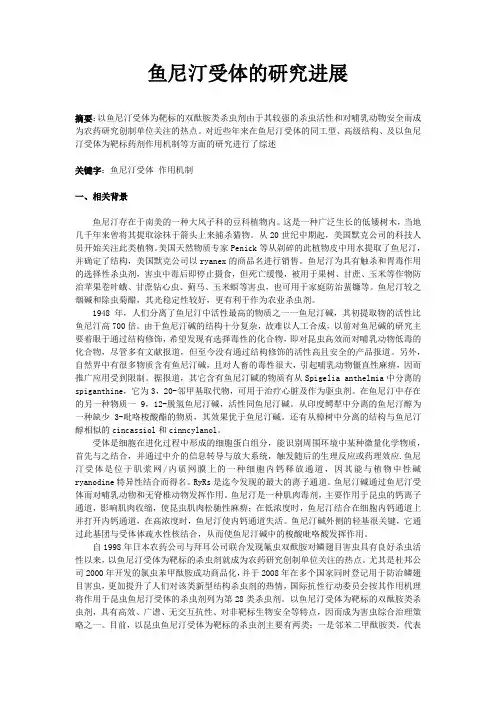
鱼尼汀受体的研究进展摘要:以鱼尼汀受体为靶标的双酞胺类杀虫剂由于其较强的杀虫活性和对哺乳动物安全而成为农药研究创制单位关注的热点。
对近些年来在鱼尼汀受体的同工型、高级结构、及以鱼尼汀受体为靶标药剂作用机制等方面的研究进行了综述关键字:鱼尼汀受体作用机制一、相关背景鱼尼汀存在于南美的一种大风子科的豆科植物内。
这是一种广泛生长的低矮树木,当地几千年来曾将其提取涂抹于箭头上来捕杀猎物。
从20世纪中期起,美国默克公司的科技人员开始关注此类植物。
美国天然物质专家Penick等从剁碎的此植物皮中用水提取了鱼尼汀,并确定了结构,美国默克公司以ryanex的商品名进行销售。
鱼尼汀为具有触杀和胃毒作用的选择性杀虫剂,害虫中毒后即停止摄食,但死亡缓慢,被用于果树、甘蔗、玉米等作物防治苹果卷叶蛾、甘蔗钻心虫、蓟马、玉米螟等害虫,也可用于家庭防治蜚镰等。
鱼尼汀较之烟碱和除虫菊醋,其光稳定性较好,更有利于作为农业杀虫剂。
1948年,人们分离了鱼尼汀中活性最高的物质之一一鱼尼汀碱,其初提取物的活性比鱼尼汀高700倍。
由于鱼尼汀碱的结构十分复杂,故难以人工合成,以前对鱼尼碱的研究主要着眼于通过结构修饰,希望发现有选择毒性的化合物,即对昆虫高效而对哺乳动物低毒的化合物,尽管多有文献报道,但至今没有通过结构修饰的活性高且安全的产品报道。
另外,自然界中有很多物质含有鱼尼汀碱,且对人畜的毒性很大,引起哺乳动物僵直性麻痹,因而推广应用受到限制。
据报道,其它含有鱼尼汀碱的物质有从Spigelia anthelmia中分离的spiganthine,它为3,20-邻甲基取代物,可用于治疗心脏及作为驱虫剂。
在鱼尼汀中存在的另一种物质一9,12-脱氢鱼尼汀碱,活性同鱼尼汀碱。
从印度鳄犁中分离的鱼尼汀醇为一种缺少3-吡咯梭酸酯的物质,其效果优于鱼尼汀碱。
还有从樟树中分离的结构与鱼尼汀醇相似的cincassiol和cinncylanol。
受体是细胞在进化过程中形成的细胞蛋白组分,能识别周围环境中某种微量化学物质,首先与之结合,并通过中介的信息转导与放大系统,触发随后的生理反应或药理效应.鱼尼汀受体是位于肌浆网/内质网膜上的一种细胞内钙释放通道,因其能与植物中性碱ryanodine特异性结合而得名。
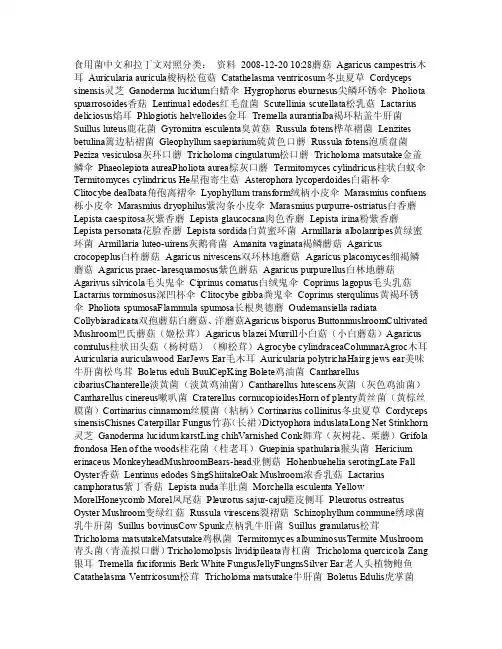
食用菌中文和拉丁文对照分类:资料2008-12-20 10:28蘑菇Agaricus campestris木耳Auricularia auricula梭柄松苞菇Catathelasma ventricosum冬虫夏草Cordyceps sinensis灵芝Ganoderma lucidum白蜡伞Hygrophorus eburnesus尖鳞环锈伞Pholiota spuarrosoides香菇Lentinual edodes红毛盘菌Scutellinia scutellata松乳菇Lactarius deliciosus焰耳Phlogiotis helvelloides金耳Tremella aurantialba褐环粘盖牛肝菌Suillus luteus鹿花菌Gyromitra esculenta臭黄菇Russula fotens桦革褶菌Lenzites betulina篱边粘褶菌Gleophyllum saepiarium硫黄色口蘑Russula fotens泡质盘菌Peziza vesiculosa灰环口蘑Tricholoma cingulatum松口蘑Tricholoma matsutake金盖鳞伞Phaeolepiota aureaPholiota aurea棕灰口蘑Termitomyces cylindricus柱状白蚁伞Termitomyces cylindricus He星孢寄生菇Asterophora lycoperdoides白霜杯伞Clitocybe dealbata角孢离褶伞Lyophyllum transform绒柄小皮伞Marasmius confuens 栎小皮伞Marasmius dryophilus紫沟条小皮伞Marasmius purpurre-ostriatus白香蘑Lepista caespitosa灰紫香蘑Lepista glaucocana肉色香蘑Lepista irina粉紫香蘑Lepista personata花脸香蘑Lepista sordida白黄蜜环菌Armillaria albolanripes黄绿蜜环菌Armillaria luteo-uirens灰鹅膏菌Amanita vaginata褐鳞蘑菇Agaricus crocopeplus白杵蘑菇Agaricus nivescens双环林地蘑菇Agaricus placomyces细褐鳞蘑菇Agaricus praec-laresquamosus紫色蘑菇Agaricus purpurellus白林地蘑菇Agarivus silvicola毛头鬼伞Ciprinus comatus白绒鬼伞Coprinus lagopus毛头乳菇Lactarius torminosus深凹杯伞Clitocybe gibba粪鬼伞Coprinus sterqulinus黄褐环锈伞Pholiota spumosaFlammula spumosa长根奥德蘑Oudemansiella radiata Collybiaradicata双孢蘑菇白蘑菇、洋蘑菇Agaricus bisporus ButtonmushroomCultivated Mushroom巴氏蘑菇(姬松茸)Agaricus blazei Murrill小白菇(小白蘑菇)Agaricus comtulus柱状田头菇(杨树菇)(柳松茸)Agrocybe cylindraceaColumnarAgroc木耳Auricularia auriculawood EarJews Ear毛木耳Auricularia polytrichaHairg jews ear美味牛肝菌松鸟茸Boletus eduli BuulCepKing Bolete鸡油菌Cantharellus cibariusChanterelle淡黄菌(淡黄鸡油菌)Cantharellus lutescens灰菌(灰色鸡油菌)Cantharellus cinereus嗽叭菌Craterellus cornucopioidesHorn of plenty黄丝菌(黄棕丝膜菌)Cortinarius cinnamom丝膜菌(粘柄)Cortinarius collinitus冬虫夏草Cordyceps sinensisChisnes Caterpillar Fungus竹荪(长裙)Dictyophora induslataLong Net Stinkhorn 灵芝Ganoderma lucidum karstLing chihVarnished Conk舞茸(灰树花、栗蘑)Grifola frondosa Hen of the woods桂花菌(桂老耳)Guepinia spathularia猴头菌Hericium erinaceus MonkeyheadMushroomBears-head亚侧菇Hohenbuehelia serotingLate Fall Oyster香菇Lentinus edodes SingShiitakeOak Mushroom浓香乳菇Lactarius camphoratus紫丁香菇Lepista nuda羊肚菌Morchella esculenta Yellow MorelHoneycomb Morel凤尾菇Pleurotus sajur-caju糙皮侧耳Pleurotus ostreatus Oyster Mushroom变绿红菇Russula virescens裂褶菇Schizophyllum commune绣球菌乳牛肝菌Suillus bovinusCow Spunk点柄乳牛肝菌Suillus granulatus松茸Tricholoma matsutakeMatsutake鸡枞菌Termitomyces albuminosusTermite Mushroom 青头菌(青盖拟口蘑)Tricholomolpsis lividipileata青杠菌Tricholoma quercicola Zang 银耳Tremella fuciformis Berk White FungusJellyFungnsSilver Ear老人头植物鲍鱼Catathelasma Ventricosum松茸Tricholoma matsutake牛肝菌Boletus Edulis虎掌菌Sarcodon aspratusBerkS.Ito春羊肚菌Morchella esculenta冷菌Lyophyllum decastesFr.ex fx.Sing鸡油菌Cantharellus cibarius部分野生真菌名录2006-05-18 14:01:13标签:野生真菌野生菌食用菌药用菌部分野生真菌名录2003/06/08 23:09标签:野生真菌野生菌食用菌药用菌目录:野生食用蘑菇浏览字体:大中小黑龙江林下野生真菌极其丰富,这里,我仅选取其中重要的菌种,形成以下名录。
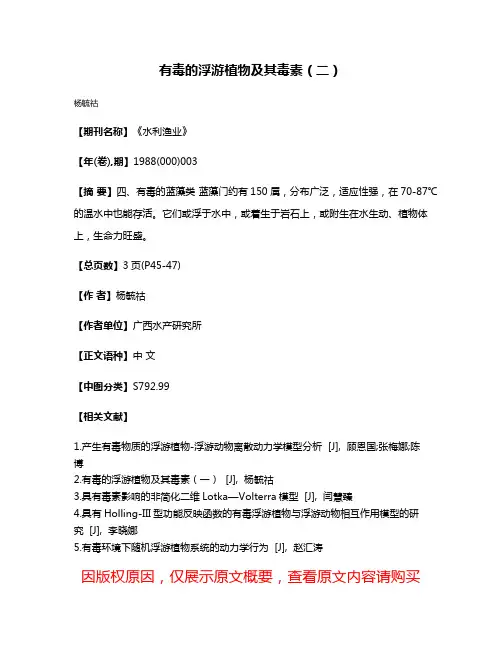
有毒的浮游植物及其毒素(二)
杨毓祜
【期刊名称】《水利渔业》
【年(卷),期】1988(000)003
【摘要】四、有毒的蓝藻类蓝藻门约有150属,分布广泛,适应性强,在70-87℃的温水中也能存活。
它们或浮于水中,或着生于岩石上,或附生在水生动、植物体上,生命力旺盛。
【总页数】3页(P45-47)
【作者】杨毓祜
【作者单位】广西水产研究所
【正文语种】中文
【中图分类】S792.99
【相关文献】
1.产生有毒物质的浮游植物-浮游动物离散动力学模型分析 [J], 顾恩国;张梅娜;陈
博
2.有毒的浮游植物及其毒素(一) [J], 杨毓祜
3.具有毒素影响的非简化二维Lotka—Volterra模型 [J], 闫慧臻
4.具有Holling-III型功能反映函数的有毒浮游植物与浮游动物相互作用模型的研
究 [J], 李晓娜
5.有毒环境下随机浮游植物系统的动力学行为 [J], 赵汇涛
因版权原因,仅展示原文概要,查看原文内容请购买。
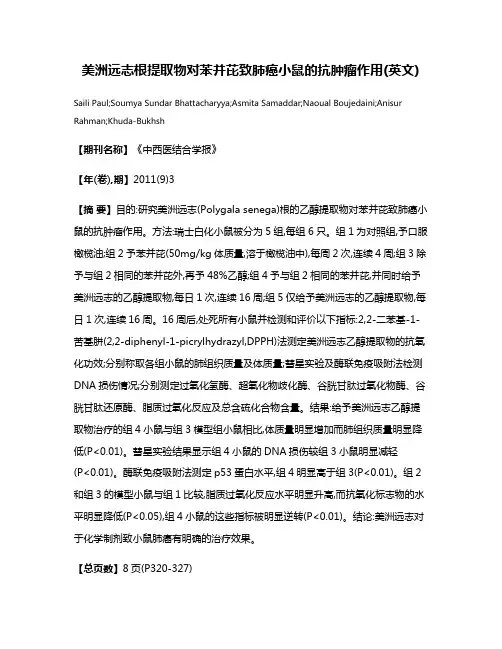
美洲远志根提取物对苯并芘致肺癌小鼠的抗肿瘤作用(英文)Saili Paul;Soumya Sundar Bhattacharyya;Asmita Samaddar;Naoual Boujedaini;Anisur Rahman;Khuda-Bukhsh【期刊名称】《中西医结合学报》【年(卷),期】2011(9)3【摘要】目的:研究美洲远志(Polygala senega)根的乙醇提取物对苯并芘致肺癌小鼠的抗肿瘤作用。
方法:瑞士白化小鼠被分为5组,每组6只。
组1为对照组,予口服橄榄油;组2予苯并芘(50mg/kg体质量,溶于橄榄油中),每周2次,连续4周;组3除予与组2相同的苯并芘外,再予48%乙醇;组4予与组2相同的苯并芘,并同时给予美洲远志的乙醇提取物,每日1次,连续16周;组5仅给予美洲远志的乙醇提取物,每日1次,连续16周。
16周后,处死所有小鼠并检测和评价以下指标:2,2-二苯基-1-苦基肼(2,2-diphenyl-1-picrylhydrazyl,DPPH)法测定美洲远志乙醇提取物的抗氧化功效;分别称取各组小鼠的肺组织质量及体质量;彗星实验及酶联免疫吸附法检测DNA损伤情况;分别测定过氧化氢酶、超氧化物歧化酶、谷胱甘肽过氧化物酶、谷胱甘肽还原酶、脂质过氧化反应及总含硫化合物含量。
结果:给予美洲远志乙醇提取物治疗的组4小鼠与组3模型组小鼠相比,体质量明显增加而肺组织质量明显降低(P<0.01)。
彗星实验结果显示组4小鼠的DNA损伤较组3小鼠明显减轻(P<0.01)。
酶联免疫吸附法测定p53蛋白水平,组4明显高于组3(P<0.01)。
组2和组3的模型小鼠与组1比较,脂质过氧化反应水平明显升高,而抗氧化标志物的水平明显降低(P<0.05),组4小鼠的这些指标被明显逆转(P<0.01)。
结论:美洲远志对于化学制剂致小鼠肺癌有明确的治疗效果。
【总页数】8页(P320-327)【关键词】远志属;苯并芘;肺肿瘤;抗肿瘤药,植物;小鼠【作者】Saili Paul;Soumya Sundar Bhattacharyya;Asmita Samaddar;Naoual Boujedaini;Anisur Rahman;Khuda-Bukhsh【作者单位】Cytogenetics and Molecular Biology Laboratory,Department of Zoology,University of Kalyani,Kalyani 741235,India;Boiron Laboratory,20,rue de la Liberation,Sainte-Les-Foy-Lyon,France【正文语种】中文【中图分类】R378.12【相关文献】1.美洲大蠊提取物对乙醇致小鼠急性胃溃疡的预防作用 [J], 邹俊波;桑文涛;王芳;杨胜群;张彤;曾南2.美洲大蠊提取物对小鼠3LL肺癌的抑制作用及其机制探讨 [J], 蒋永新;王熙才;金从国;陈晓群;李佳;伍治平;刘光明;李树楠3.黄花远志根和叶提取物对急性肝损伤小鼠的保护作用 [J], 谢伟容;高斐雄;林燕燕;陈素慧;郭献忠4.美洲大蠊提取物对Lewis肺癌小鼠抑瘤作用的研究 [J], 蒋永新;王熙才;金从国;陈晓群;王前;刘光明5.美洲大蠊不同工艺提取物对四氯化碳致急性肝损伤小鼠肝脏的保护作用 [J], 周湘;刘学聪;张文超;陈玮璨;刘昕因版权原因,仅展示原文概要,查看原文内容请购买。
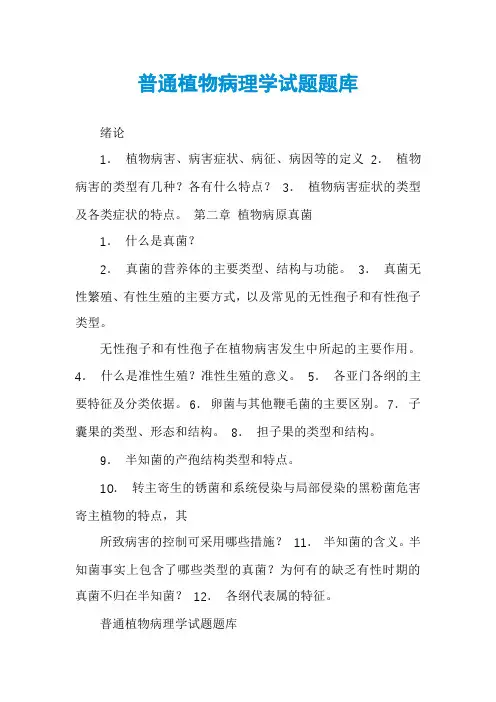
普通植物病理学试题题库绪论1.植物病害、病害症状、病征、病因等的定义2.植物病害的类型有几种?各有什么特点?3.植物病害症状的类型及各类症状的特点。
第二章植物病原真菌1.什么是真菌?2.真菌的营养体的主要类型、结构与功能。
3.真菌无性繁殖、有性生殖的主要方式,以及常见的无性孢子和有性孢子类型。
无性孢子和有性孢子在植物病害发生中所起的主要作用。
4.什么是准性生殖?准性生殖的意义。
5.各亚门各纲的主要特征及分类依据。
6.卵菌与其他鞭毛菌的主要区别。
7.子囊果的类型、形态和结构。
8.担子果的类型和结构。
9.半知菌的产孢结构类型和特点。
10.转主寄生的锈菌和系统侵染与局部侵染的黑粉菌危害寄主植物的特点,其所致病害的控制可采用哪些措施?11.半知菌的含义。
半知菌事实上包含了哪些类型的真菌?为何有的缺乏有性时期的真菌不归在半知菌?12.各纲代表属的特征。
普通植物病理学试题题库第一部分:拉丁学名一、病原菌拉丁学名1、真菌Plasmodiophora (根肿菌属)Physoderma (节壶菌属)Achlya (绵霉属)Pythium (腐霉属)Phytophthora(疫霉属)Peronospora(霜霉属)Spongospora (粉痂菌属)Polymyxa (多粘菌属)Saprolegnia (水霉属)Aphanomyces(丝囊霉属)Sclerospora(指梗霉属)Plasmopara (单轴霉属)Pseudoperonospora (假霜霉属)Bremia (盘梗霉属)Albugo (白锈属)Peronophthora(霜疫霉属)Rhizopus (根霉属)Mucor(毛霉属)Choanephora(笄霉属)Absidia(犁头霉属)Taphrina(外囊菌属)Blumeria(布氏白粉属)Ceratocystis (长喙壳属)Gibberella(赤霉属)Valsa(黑腐皮壳属)Elsinoe (痂囊腔菌属)Guignardia(球座菌属)Venturia (黑星菌属)Sclerotinia (核盘菌属)Erysiphe(白粉属属)Sphaerotheca(单丝壳属)Podosphaera (叉丝单囊壳属)Phyllactinia(球针壳属)Uncinula (钩丝壳属)Microsphaera(叉丝壳属)Meliola(小煤炱属)Glomerella (小丛壳属)Gaeumannomyces(顶囊壳属)Cryphonectria(隐球丛赤壳属)Gnomonia(日规壳属)Phyllachora(黑痣菌属)Diaporthe (间座壳属)Claviceps (麦角菌属)Myrangium(多腔菌属)Mycosphaerella(球腔菌属)Sphaerulina(亚球壳属)Pleospora(格孢腔菌属)Pyrenophora (核腔菌属)Cochliobolus(旋孢腔菌属)Rhytisma(斑痣盘菌属)Lophodermium (散斑壳属)Puccinia(柄锈菌属)Gymnosporangium(胶锈菌属)Ustilago (黑粉菌属)Tranzschelia (疣双胞锈菌属)Uromyces (单胞锈菌属)Phakopsora 锈菌属)Melampsora (栅锈菌属)Urocystis (条黑粉菌属)Entyloma (叶黑粉菌属)Tilletia (腥黑粉菌属)Sphacelotheca (轴黑粉菌属)Neovossia (尾孢黑粉菌属)Doassansia (实球黑粉菌属)Septobasidium (隔担菌属)Helicobasidium (卷担子属)Exobasidium (外担菌属)Phragmidium (多胞锈菌属)Pyricularia (梨孢属属)Penicillium (青霉属)Bipolaris (平脐蠕孢属)Fusarium (镰孢属)Rhizoctonia (丝核菌属)Colletotrichum (炭疽菌属)Macrophomina (壳球孢属)Monilia (丛梗孢属)Botrytis (葡萄孢属)Trichothecium (聚瑞孢属)Ramularia (柱隔孢属)Oidium (粉孢属)Aspergillus (曲霉属)Verticillium (轮枝孢属)Cercospora (尾孢属)Alternaria (链格孢属)Cladosporium(枝孢属)Fusicladium (黑星孢属)Drechslera(内脐蠕孢属)Exserohilum (突脐蠕孢属)Curvularia (弯孢属)Sclerotium (小核菌属)Ustilaginoidea (绿核菌属)Sphaceloma (痂圆孢属)Marssonina (盘二孢属)Cylindrosporium (柱盘孢属)Pestalotia (盘多毛孢属)Phoma (茎点霉属)Phyllosticta (叶点霉属)Macrophoma (大茎点霉属)Phomopsis (拟茎点霉属)Septoria (壳针孢属)Cytospora (壳囊孢属)Diplodia (色二孢属)Ascochyta(壳二孢属)二、请写出引起下列病害的病原菌拉丁文属名(不写种名)十字花科霜霉病十字花科软腐病茄科青枯病马铃薯晚疫病小麦白粉病稻瘟病柑橘溃疡病棉花枯萎病(层第二部分:名词解释半寄生:孢囊孢子(sporangiospore):孢子(spore):孢子囊(sporangium):胞间联丝:胞囊(cyst):被动抗病性(passive resistance):闭囊壳(cleistothecium):避病性(avoidance):并发症(complex symptoms):病毒(Virus):病害三角(disease triangle):病害循环(disease cycle):病害严重度(disease severity):病情指数(disease index):病因:病原生物(pathogen):病征(sign):藏卵器(oogonitun):层出现象(proliferation):长生活史型(long life-cycle):初次侵染(Primary infection):初生菌丝体(primary myceliun):次生菌丝体(secondary mycelium):单分体病毒:单循环病害(monocyclic disease):单游现象(rnonoplanetism):单主寄生(autoecism):担孢子(basidiospore):担子(basidium):担子果(basidiocarp):垫刃型食道(Tylenchoid oesophagi):冬孢子(teliospore):毒素(toxin):短生活史型(short life-cycle):多分体病毒:多型现象(polymorphism):多循环病害(polycyclic disease):发病率(incidence):发病期(symptom appearance):非寄主抗性(non-host-resistance):非寄主专化性毒素(host-non-specifictoxin):非侵染性病害(Noninfectious diseases):非小种专化抗病性(race-nonspecific re-sistance):非循回型(noncirulative):分生孢子(conidiurn):分生孢子座(sporodochium):分生孢子梗(conidiophore):分生孢子盘(acervulus):分生孢子器(pycnidium):腐生物(saprogen):附生植物(adnascent plant):附属丝(appendage):附着胞(appressorium):复制增殖(multiplication):刚毛(seta):共栖(commensalism):共生〔symbiosis〕:过敏性坏死反应(necrotic hypersensitivereaction):合子(zygote):核配(karyogamy):厚垣孢子(chlamydospore):滑刃型食道(Aphelenchoid oesophagi):会阴花纹(perineal pattern):活体营养型(biotrophe):获毒(取食)期(acquisition period):基因对基因学说(gene-for-gene theory):季节流行曲线(disease progress curve):寄生物(parasite):寄生性(parasitism):寄生性植物(paraatic plaut):寄生专化性(specialized parasitism):寄主(host):寄主专化性毒素(host specific toxin):假根(rhizoid):假菌丝(pseudomycelium):假囊壳(psendoperithecium或pseudothecium):兼性寄生物(facultative parasite):减数分裂(meiosis):检疫法规(quarantine regulations):胶质(gum):接合孢子〔zygospore〕:节孢子(arthrospore):介体传播(vector transmission):经济阈值(economicthreshold):菌核(sclerotium):菌落(colony):菌丝(hypha):菌丝融合(anastomosis):菌丝型分生孢子:菌索(rhizomorph):苗网(networks loops):抗病性(resistance to disease):抗逆性(resistance):柯赫氏法则(Koch's Rule),类病毒(Viroid):两游现象(diplanetism):卵孢子(oospore):卵囊(egg sac):卵球(oosphere):逻辑斯蒂增长期:矛型食道(Dorylaimoid oesophagi):木栓化(suberization):内含体(inclusions):耐病性(tolerance):拟薄壁组织(pseudoparenchyrna):农业防治:配子(gamete):配子囊配合(gametangial copulation):喷菌现象(bacteria exudation, BE):匍匐菌丝(stolon):潜育期(incubation period):侵染过程(infection process):侵染剂量(infection dosage):侵染性病害(infection disease):侵入期(penetration period):侵填体(tylose):全锈型(eu-form rust):缺素症(nutrition deficiencies):茸鞭(tinsel):神经环(nerve ring):生化变种(biovar):生活史(life cycle):生物防治(biological control):受精作用(spermatization):疏丝组织(prosenchyma):死体营养型(necrotroph):锁状联合(clamp connection):同宗配合(homothallism):微效基因抗病性(minor gene resistance):尾鞭(whiplash):。
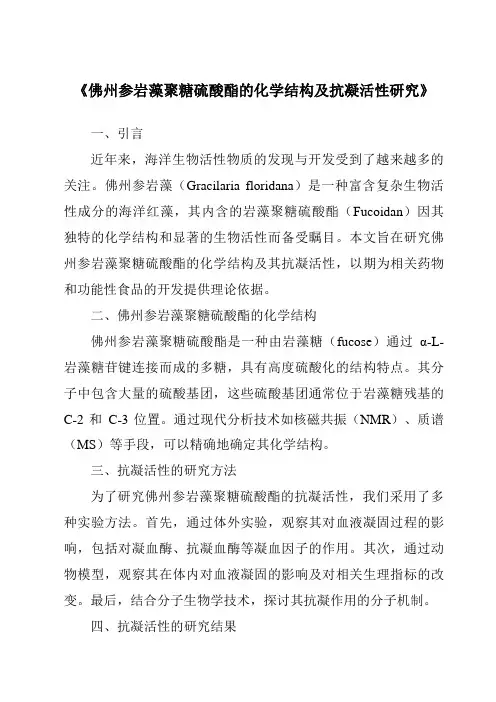
《佛州参岩藻聚糖硫酸酯的化学结构及抗凝活性研究》一、引言近年来,海洋生物活性物质的发现与开发受到了越来越多的关注。
佛州参岩藻(Gracilaria floridana)是一种富含复杂生物活性成分的海洋红藻,其内含的岩藻聚糖硫酸酯(Fucoidan)因其独特的化学结构和显著的生物活性而备受瞩目。
本文旨在研究佛州参岩藻聚糖硫酸酯的化学结构及其抗凝活性,以期为相关药物和功能性食品的开发提供理论依据。
二、佛州参岩藻聚糖硫酸酯的化学结构佛州参岩藻聚糖硫酸酯是一种由岩藻糖(fucose)通过α-L-岩藻糖苷键连接而成的多糖,具有高度硫酸化的结构特点。
其分子中包含大量的硫酸基团,这些硫酸基团通常位于岩藻糖残基的C-2和C-3位置。
通过现代分析技术如核磁共振(NMR)、质谱(MS)等手段,可以精确地确定其化学结构。
三、抗凝活性的研究方法为了研究佛州参岩藻聚糖硫酸酯的抗凝活性,我们采用了多种实验方法。
首先,通过体外实验,观察其对血液凝固过程的影响,包括对凝血酶、抗凝血酶等凝血因子的作用。
其次,通过动物模型,观察其在体内对血液凝固的影响及对相关生理指标的改变。
最后,结合分子生物学技术,探讨其抗凝作用的分子机制。
四、抗凝活性的研究结果1. 体外实验结果:佛州参岩藻聚糖硫酸酯在体外实验中表现出显著的抗凝活性,能够显著抑制凝血酶的活性,增强抗凝血酶的作用,从而有效延长活化部分凝血活酶时间(APTT)和凝血酶原时间(PT)。
2. 动物模型实验结果:在动物模型中,佛州参岩藻聚糖硫酸酯能够显著改善高凝状态,降低血液粘度,预防血栓形成。
同时,对相关生理指标如血小板计数、纤维蛋白原等也有显著的调节作用。
3. 分子机制研究:通过分子生物学技术,我们发现佛州参岩藻聚糖硫酸酯能够与凝血因子结合,抑制其活性;同时还能促进内源性抗凝系统的活性,从而发挥抗凝作用。
五、结论本研究表明,佛州参岩藻聚糖硫酸酯具有独特的化学结构和显著的抗凝活性。
其抗凝作用主要体现在体外对凝血酶的抑制作用、体内改善高凝状态以及调节相关生理指标等方面。
![具有杀线虫活性的几丁质-蛋白质复合物[发明专利]](https://uimg.taocdn.com/719b566fd0d233d4b14e69f3.webp)
专利名称:具有杀线虫活性的几丁质-蛋白质复合物
专利类型:发明专利
发明人:罗伯特·奥斯汀·米尔殊,拉塞尔·J·麦坎德利什,巴巴拉·J·伊斯特伍德
申请号:CN85104021
申请日:19850522
公开号:CN85104021A
公开日:
19870114
专利内容由知识产权出版社提供
摘要:由甲壳纲类的含几丁质生物废料制造几丁质-蛋白质复合物。
这种复合物不同于几丁质和脱乙酰壳多糖,具有对农业和园艺有用的干扰和杀线虫活性。
应用方法是将杀线虫有效量的复合物与植物生长培养基混合。
此复合物还提供一种慢性释放氮源,使得它特别适宜于与肥料和土壤调节剂联合使用。
申请人:IGI生物科技公司
地址:美国马里兰州哥伦比亚
国籍:US
代理机构:中国专利代理有限公司
更多信息请下载全文后查看。
苯并二氢吡喃衍生物抗去势雌鼠骨质疏松的作用侯进;熊晓云;弥曼;曾菊绒;胥晓丽【期刊名称】《中国老年学杂志》【年(卷),期】2015(0)24【摘要】目的:探讨苯并二氢吡喃衍生物替代xy9902对去势雌鼠骨质疏松的治疗作用及其机制。
方法切除雌性 SD大鼠双侧卵巢,制备大鼠骨质疏松模型,用化合物xy9902灌胃给药,观察xy9902对去势雌鼠骨密度的影响;同时检测大鼠体内血清钙、血清磷及碱性磷酸酶、白细胞介素(IL)-6等生化指标。
结果去势后大鼠骨密度下降,使用灌胃3个月后,能明显抑制去势雌鼠骨密度的下降,对血钙、血磷没有明显影响,降低血中ALP含量,抑制IL-6分泌。
结论化合物xy9902通过与去势雌鼠体内雌激素受体结合,影响去势大鼠骨代谢,增强去势雌鼠骨密度,抗骨质疏松。
【总页数】2页(P6996-6997)【作者】侯进;熊晓云;弥曼;曾菊绒;胥晓丽【作者单位】西安医学院,陕西西安 710068;西安利君制药有限责任公司;西安医学院,陕西西安 710068;西安医学院,陕西西安 710068;西安医学院,陕西西安710068【正文语种】中文【中图分类】R68【相关文献】1.苯并二氢吡喃衍生物抗骨质疏松活性的构效关系研究 [J], 熊晓云;陈亚琼;邹永;梅其炳;赵德化;孙兰;刘景生2.苯并二氢吡喃衍生物的抗乳腺癌作用 [J], 侯进3.苯并二氢吡喃衍生物的抗乳腺癌作用 [J], 侯进4.以淀粉溶液为催化剂一锅三组分法合成四氢苯并[b]吡喃和3,4-二氢吡喃并[c]苯并吡喃衍生物(英文) [J], Nourallah Hazeri;Malek TaherMaghsoodlou;Fatemeh Mir;Mehrnoosh Kangani;HamidehSaravani;Ebrahim Molashahi5.6,7-亚甲二氧基硫代苯并二氢吡喃-4-酮衍生物的合成及抑菌活性 [J], 王润润;朱伟伟;王阿莉;胡雷;周文明因版权原因,仅展示原文概要,查看原文内容请购买。
青岛农业大学硕士学位论文桑黄菌生物学特性研究姓名:***申请学位级别:硕士专业:植物病理学指导教师:***20070601壹墨坐些叁兰堡±堡塞丝墨兰坌旦平板培养条件下,不同起始pH对桑黄菌丝体生长的影响见表1.3、1.4和图1.2,综合分析上述图表中的试验结果发现,当起始pH在pH4.10之I刨时,桑黄菌丝体都能够生长;适宜桑黄菌丝体生长的范围pH6—8;pH7的处理菌丝生长速度最快。
1.22液体深层发酵培养试验图13起始pH对桑黄发酵液pH变化的影响EffectofthebeginningpHtothepHchangeofthefermentedbrothofPhellinusigniariusFi91.3图1.4起始pH对桑黄发酵液多糖变化的影响oftheoutputofpolysaccharideofPheltinusigniariusFi91.4EffectofthebeginningpHtothechange231.3装瓶量对桑黄菌液体深层培养的影响图1.5装瓶量对桑黄发酵液pH变化的影响Fi91.5EffectofthebottlingquantitytothepHchangeofthefermentedbrothofPhellinusign/anus固f.6装瓶量对桑黄发酵液多糖变化的影响Fi91.6EffectofthebottlingquantitytothechangeoftheoutputofpolysaccharideofPhellinusigniarim25青岛农业人学硕十_论文结果与分忻1.4接种量对桑黄菌丝体深层发酵影响图1.7接种量对桑黄发酵液pH变化的影响Fi91.7EffectoftheinoculationquantitytothepHchangeofthefermentedbrothofPhellinusigniarius图18接种量对桑黄发酵液多糖变化的影响Fi91.8EffectoftheinoculationquantitytothechangeoftheoutputofpolysaccharideofPhellinusigniarius27青岛农业人学硕十论文结果与分析2.1.2液体深层培养试验图22碳源对桑黄发酵液pH变化的影响brothofPhellinusigniariusFi92.2EffectofcarbonsourcestothepHchangeofthefermented图2.3碳源对桑黄发酵液多糖变化的影响Fi92.3EffectofcarbonsourcestothechangeoftheoutputofpolysaccharideofPhellinusigniarius2.2,2液体深层发酵试验图25氦源对桑黄发酵液pH变化的影响Fj醇.5EffectofnitrogensourcestothepHchangeofthefermentedbrothofPhellinusigm'arius图26氦源对桑黄发酵液多糖变化的影响Fi926EffectofnitrogensourcestothechangeoftheoutputofpolysaccharideofPhellinusigniarius37青岛农业人学硕十论文结果与分析生长阶段所需碳氮比略小于生殖生长阶段。
木糖氧化产碱杆菌反硝化亚种以木糖氧化产碱杆菌反硝化亚种为标题,本文将介绍木糖氧化产碱杆菌的特点以及其反硝化亚种的研究进展。
一、木糖氧化产碱杆菌的特点木糖氧化产碱杆菌(Pseudomonas stutzeri)是一种革兰氏阴性杆菌,属于假单胞菌属(Pseudomonas),广泛存在于土壤、水体和动植物体内。
该菌种具有多样的代谢途径和生理特点,能够利用多种有机物质作为碳源进行生长。
其中,木糖氧化产碱杆菌具有利用木糖(xylose)进行氧化代谢的能力,是目前已知唯一能够利用木糖的假单胞菌属菌种。
木糖氧化产碱杆菌的代谢途径中,木糖被氧化为二酮酸(2-ketogluconate),同时产生电子和质子(H+)供给细胞内部的能量代谢。
此外,木糖氧化产碱杆菌还能产生一种特殊的酶——木糖醛酸脱氢酶(xyloquinone dehydrogenase),该酶能够将木糖醛酸(xyloquinone)还原为木糖,使得木糖氧化产碱杆菌能够循环利用木糖进行氧化代谢。
二、木糖氧化产碱杆菌反硝化亚种的研究进展反硝化是一种微生物代谢过程,指的是细菌利用硝酸盐(nitrate)或亚硝酸盐(nitrite)作为电子受体进行呼吸代谢,将硝酸盐还原为氮气(N2)或氮氧化物(N2O)。
木糖氧化产碱杆菌也具有反硝化的能力,但其反硝化途径与其他细菌略有不同。
木糖氧化产碱杆菌反硝化的关键酶是亚硝酸还原酶(nitrite reductase),该酶能够将亚硝酸盐还原为氮气。
木糖氧化产碱杆菌的反硝化途径中,亚硝酸还原酶的活性与木糖氧化产碱杆菌的木糖醛酸脱氢酶密切相关。
研究发现,木糖醛酸脱氢酶的表达水平与亚硝酸还原酶的活性呈正相关,即木糖氧化产碱杆菌的木糖醛酸脱氢酶活性越高,其反硝化能力也越强。
近年来,对木糖氧化产碱杆菌反硝化亚种的研究进展日益增多。
通过对不同来源的木糖氧化产碱杆菌进行基因组分析,发现存在多个反硝化相关基因簇,预示着木糖氧化产碱杆菌的反硝化亚种可能存在差异。
剧毒物品品名表(GB58-93)发出日期:2006-07-08请按[Ctrl]+[F]进行检索第1类A级无机剧毒物品中文名:氰化钠(山奈)英文名:Sodium Cyanide分子式:NaCNGA No. A1001GB No. 61001UN No. 1689中文名:氰化钾(山奈钾)英文名:Potassium Cyanide分子式:KCNGA No. A1002GB No. 61001UN No. 1680中文名:氰化钙英文名:Calcium Cyanide分子式:Ca(CN)2GA No. A1003GB No. 61001UN No. 1575中文名:氰化钡英文名:Barium Cyanide分子式:Ba(CN)2GA No. A1004GB No. 61001中文名:氰化钴英文名:Cobalt Cyanide分子式:Co(CN)2?2H2OGA No. A1005GB No. 61001UN No. 1588中文名:氰化亚钴英文名:Cobalthous Cyanide分子式:Co(CN)2?2H2OGA No. A1006GB No.UN No. 1588中文名:氰化钴钾(钴氰化钾)英文名:Potassium Cobalt Cyanide 分子式:K3[Co(CN)6]GA No. A1007GB No.UN No. 1588中文名:氰化镍(氰化亚镍)英文名:Nickel Cyanide分子式:Ni(CN)2?4H2OGA No. A1008GB No. 61001UN No. 1653中文名:氰化镍钾(氰化钾镍)英文名:Potassium Nickel Cyanide 分子式:K2[Ni(CN)4]?H2OGA No. A1009UN No. 1588中文名:氰化铜(氰化高铜)英文名:Cupric Cyanide; Copper (Ⅱ) Cyanide 分子式:Cu(CN)2GA No. A1010GB No. 61001UN No. 1587中文名:氰化银英文名:Silver Cyanide分子式:AgCNGA No. A1011GB No. 61001UN No. 1684中文名:氰化银钾(银氰化钾)英文名:Potassium Silver Cyanide分子式:KAg(CN)2GA No. A1012GB No. 61001UN No. 1588中文名:氰化锌英文名:Zinc Cyanide分子式:Zn(CN)2GA No. A1013GB No. 61001UN No. 1713中文名:氰化镉英文名:Cadmium Cyanide分子式:Cd(CN)2GB No. 61001UN No. 1588中文名:氰化汞(氰化高汞)英文名:Mercuric Cyanide分子式:Hg(CN)2GA No. A1015GB No. 61001UN No. 1636中文名:氰化汞钾(氰化钾汞,汞氰化钾)英文名:Mercuric Potassium Cyanide分子式:Hg(CN)2?2KCNGA No. A1016GB No. 61001UN No. 1626中文名:氰化铅英文名:Lead Cyanide分子式:Pb(CN)2GA No. A1017GB No. 61001UN No. 1620中文名:氰化铈英文名:Cerium Cyanide分子式:Ce(CN)4GA No. A1018GB No. 61001UN No. 1588中文名:氰化亚铜英文名:Cuprous Cyanide分子式:CuCNGA No. A1019GB No. 61001UN No. 1588中文名:氰化金钾(氰化钾金、氰金酸钾)英文名:Gold Potassiu,m Cyanide分子式:KAu(CN)2GA No. A1020GB No. 61001UN No. 1588中文名:氰化溴(溴化氰)英文名:Bromine Cyanide,Cyanogen Bromide分子式:BrCNGA No. A1021GB No. 61001UN No. 1889中文名:氰化氢[液化的](无水氢氰酸)英文名:Hydrogen Cyanide分子式:HCNGA No. A1022GB No. 61003UN No. 1051中文名:氰化氢[含量≤20%]英文名:Hydrocyanic acid ≤20% Solution分子式:HCN(≤20%)GA No. A1023GB No. 61004UN No. 1613中文名:三氧化(二)砷[白砒;砒霜;亚砷(酸)酐]英文名:Arsenic trioxide分子式:As2O3GA No. A1024GB No. 61007UN No. 1561中文名:亚砷酸钠(偏亚砷酸钠)英文名:Sodium Arsenite分子式:NaAsO2GA No. A1025GB No. 61009UN No. 2027中文名:亚砷酸钾英文名:Potassium Arsenite分子式:KAsO2; KAsO2?HAsO2GA No. A1026GB No. 61009UN No. 1678中文名:五氧化(二)砷[砷(酸)酐]英文名:Arsenic pentoxide分子式:As2O5GA No. A1027GB No. 61010UN No. 1559中文名:三氯化砷(氯化亚砷)英文名:Arsenous trichloride分子式:AsCl3GA No. A1028GB No. 61013UN No. 1560中文名:亚硒酸钠英文名:Sodium Selenite分子式:Na2SeO3?5H2OGA No. A1029GB No. 61016UN No. 2630中文名:亚硒酸钾英文名:Potassium Selenite分子式:K2SeO3GA No. A1030GB No. 61016UN No. 2630中文名:硒酸钠英文名:Sodium Selenite分子式:Na2SeO4?10H2OGA No. A1031GB No. 61017UN No. 2630中文名:硒酸钾英文名:Potassium Selenite分子式:K2SeO4GA No. A1032GB No. 610017UN No. 2630中文名:氧氯化硒(氯化亚硒酰;二氯氧化硒)英文名:Selenium Oxychloride分子式:SeOClGA No. A1033GB No. 81039中文名:氯化汞(氯化高汞;二氯化汞)英文名:Mercuric Chloride分子式:HgCl2GA No. A1034GB No. 61030UN No. 1624中文名:氧氰化汞(氰氧化汞)英文名:Mercuric Oxycyanide分子式:Hg(CN)2?HgOGA No. A1035GB No. 61030UN No. 1642中文名:氧化镉[粉状]英文名:Cadmium Oxide分子式:CdOGA No. A1036GB No. ------UN No. 2570中文名:羰基镍(四羰基镍;四碳酰镍)英文名:Nickel Carbonyl分子式:Ni(CO)4GA No. A1037GB No. 61031UN No. 1259中文名:五羰基铁(羰基铁)英文名:Lron Pentacarbonyl分子式:Fe(CO)5GA No. A1038UN No. 1994中文名:迭氮(化)钠英文名:Sodium Azide分子式:NaN3GA No. A1039GB No. 61033UN No. 1687中文名:迭氮(化)钡英文名:Barium Azide分子式:Ba(N3)2GA No. A1040GB No. 11018UN No. 0224中文名:迭氮酸(迭氮化氢)英文名:Hydrazoic acid分子式:HN3GA No. A1041GB No. ------UN No. ------中文名:氟化氢(无水)(无水氢氟酸)英文名:Hydrogen Fluoride分子式:HFGA No. A1042GB No. 81015UN No. 1052中文名:黄磷(白磷)英文名:Phosphorus Yellow; White Phosphorus 分子式:P4GB No. 42001UN No. 1381中文名:磷化钠英文名:Sodium Phosphide分子式:Na3PGA No. A1044GB No. 43032UN No. 1432中文名:磷化钾英文名:Potassium Phosphide分子式:K3PGA No. A1045GB No. 43033UN No. 2012中文名:磷化铝英文名:Aluminium Phosphide分子式:AlPGA No. A1047GB No. 43036UN No. 1397中文名:磷化铝农药英文名:Aluminium Phosphide Pesticides 分子式:------GA No. A1048GB No. 61124UN No. 3048中文名:氟[压缩的]英文名:Fluorine分子式:F2GA No. A1049GB No. 23001UN No. 1045中文名:氯[液化的](液氯)英文名:Chlorine, Lignefied分子式:Cl2GA No. A1050GB No. 23002UN No. 1017中文名:磷化氢(磷化三氢;膦)英文名:Hydrogen Phosphide; Phosphine 分子式:PH3GA No. A1051GB No. 23005UN No. 2199中文名:砷化氢(砷化三氢;胂)英文名:Arsenic Hydride; Arsine分子式:AsH3GA No. A1052GB No. 23006UN No. 2188中文名:硒化氢[无水]英文名:Hydrogen Selenide分子式:H2SeGA No. A1053GB No. 23007UN No. 2202中文名:锑化氢(锑化三氢)英文名:Hydrogen Antimonide分子式:SbH3GA No. A1054GB No. 23008UN No. 2676中文名:一氧化氮英文名:Nitric oxide; Nitrogen Monoxide分子式:NOGA No. A1055GB No. 23009UN No. 1660中文名:四氧化二氮[液化的](二氧化氮)英文名:Dinitrogen Tetroxide, liquefied分子式:N2O4, N2OGA No. A1056GB No. 23012UN No. 1067中文名:二氧化硫[液化的](亚硫酸酐)英文名:Sulfur Dioxide, Liquefied分子式:SO2GA No. A1057GB No. 23013UN No. 1079中文名:二氧化氯英文名:Chlorine Dioxide分子式:ClO2GA No. A1058GB No. *UN No. NA9091中文名:二氟化氢英文名:Oxygen difluoride分子式:OF2GA No. A1059GB No. 23014*UN No. 2190中文名:三氟化氯英文名:Chlorine Trifluoride分子式:ClF3GA No. A1060GB No. 23015*UN No. 1749中文名:三氟化磷英文名:Phosphorous Trifluoride 分子式:PF3GA No. A1061GB No. 23017*UN No. 1955中文名:四氟化硫英文名:Sulfur Tetrafluoride分子式:SF4GA No. A1062GB No. 23019*UN No. 2418中文名:四氟化硅(氟化硅)英文名:Silicon Tetrafluoride分子式:SiF4GA No. A1063GB No. 23020*中文名:五氟化氯英文名:Chlorine Pentafluoride分子式:ClF5GA No. A1064GB No. 23021*UN No. 2548中文名:五氟化磷英文名:Phosphorus Pentafluoride 分子式:PF5GA No. A1065GB No. 23022*UN No. 2198中文名:六氟化硒英文名:Selrnium Hexafluoride分子式:SeF6GA No. A1066GB No. 23023*UN No. 2194中文名:六氟化碲英文名:Tellurium Hexafluoride 分子式:TeF6GA No. A1067GB No. 23024*UN No. 2195中文名:六氟化钨英文名:Tungsten Hexafluoride分子式:WF6GA No. A1068UN No. 2196中文名:氯化溴(溴化氯)英文名:Bromine Chloride分子式:BrClGA No. A1069GB No. 23026*UN No. 2901中文名:氯化氰(氰化氯;氯甲腈)英文名:Cyanogen Chloride分子式:CNClGA No. A1070GB No. 23027*UN No. 1589中文名:溴化羰(溴光气)英文名:Carbonyl Bromide; Bromophosgene 分子式:COBr2GA No. A1071GB No. *UN No. ------中文名:氰[液化的]英文名:Cyanogen, Liquefied分子式:(CN)2GA No. A1072GB No. 23028*UN No. 1026第2类B级无机剧毒物品中文名:碘化氰英文名:Cyanogen lodide分子式:ICNGA No. B1001GB No. ------UN No. ------中文名:砷英文名:Arsenic分子式:As4GA No. B1002GB No. 61006UN No. 1558中文名:亚砷酸钙(亚砒酸钙)英文名:Calcium Arsenite分子式:Ca3(AsO3)2GA No. B1003GB No. 61009UN No. ------中文名:亚砷酸锶(原亚砷酸锶)英文名:Strontium Arenite; Strontium orthoarenite 分子式:Sr3(AsO3)2?4H2OGA No. B1004GB No. 61009UN No. 1691中文名:亚砷酸钡英文名:Barium Arsenite分子式:Ba(AsO2)2GA No. B1005GB No. 61009UN No. ------中文名:亚砷酸铁英文名:Ferric Arsenite分子式:2FeAsO3?Fe2O3?5H2OGA No. B1006GB No. 61009UN No. 1607中文名:亚砷酸铜(亚砷酸氢铜)英文名:Cupric Arsenite; Copper Arsenite分子式:CuHAsO3GA No. B1007GB No. 61009UN No. 1586中文名:亚砷酸银(原亚砷酸银)英文名:Silver Arsenite; Silver Orthoarsenite 分子式:Ag3AsO3GA No. B1008GB No. 61009UN No. 1683中文名:亚砷酸锌英文名:Zinc Arsenite分子式:Zn(AsO2)2GA No. B1009GB No. 61009UN No. 1712中文名:亚砷酸铅英文名:Lead Arsenite分子式:Pb3(AsO3)2?H2OGA No. B1010GB No. 61009UN No. 1618中文名:亚砷酸锑英文名:Antimony Arsenite分子式:SbAsO3或Sb2O3+As2O3GA No. B1011GB No. 61009UN No. ------中文名:乙酰亚砷酸铜(醋酸亚砷酸铜;翡翠绿;祖母绿;巴黎绿)英文名:Copper Acetoarsenite; Emerald Green分子式:Cu(COOCH3)2?3Cu(AsO2)2GA No. B1012GB No. 61009UN No. 1585中文名:砷酸英文名:Arsenic acid分子式:H3AsO4GA No. B1013GB No. 61011UN No. 1554中文名:偏砷酸英文名:Metaarsenic Acid分子式:HAsO3GA No. B1014GB No. 61011UN No. 1554中文名:焦砷酸英文名:Pyroarsenic Acid分子式:H4As2O7GA No. B1015GB No. 61011UN No. ?中文名:砷酸铵(砷酸氢二铵)英文名:Ammonium Arsenate; Diammonium Arsenate; Diammonium Hydroge Arsenate分子式:(NH4)2HAsO4GA No. B1016GB No. 61012UN No. 1546中文名:砷酸钠(原砷酸钠,砷酸三钠)英文名:Sodium Arsenate; Sodium Orthoarsenate; Trisodium Arsenate分子式:Na3AsO4•12H2OGA No. B1017GB No. 61012UN No. 1685中文名:偏砷酸钠英文名:Sodium Metaarsenate分子式:NaAsO3GA No. B1018GB No. 61012UN No. 1557中文名:砷酸氢二钠英文名:Sodium Arsenate Dibasic; Disodium Arsenate; Disodium Hydrogen Arsenate分子式:Na2HAsO4•7H2OGA No. B1019GB No. 61012UN No. 1557中文名:砷酸氢二钠英文名:Sodium Arsenate Dibasic; Disodium Arsenate; Disodium HydrogenArsenate分子式:Na2HAsO4•7H2OGA No. B1019GB No. 61012UN No. 1557中文名:砷酸二氢钠英文名:Sodium Arsenate Monobasic; Sodium Dihydrogen Arsenate 分子式:NaH2AsO4•H2OGA No. B1020GB No. 61012UN No. 1557中文名:砷酸二氢钾英文名:Potassium Dihydrogen Arsenate分子式:KH2AsO4GA No. B1022GB No. 61012UN No. 1677中文名:砷酸镁英文名:Magnesium Arsenate分子式:Mg3(AsO4)2•8H2OGA No. B1023GB No. 61012UN No. 1622中文名:砷酸钙(砷酸三钙)英文名:Calcium Arsenate; Tricalcium Arsenate分子式:Ca3(AsO4)2GA No. B1024GB No. 61012UN No. 1573中文名:砷酸钡英文名:Barium Arsenate分子式:Ba3(AsO4)2GA No. B1025GB No. 61012UN No. 1557中文名:砷酸铁英文名:Ferric Arsenate分子式:FeAsO4•2H2OGA No. B1026GB No. 61012UN No. 1606中文名:砷酸亚铁英文名:Ferrous Arsenate分子式:Fe3(AsO4)2•6H2OGA No. B1027GB No. 61012UN No. 1608中文名:砷酸铜英文名:Cupric Arsenate; Copper Arsenate 分子式:Cu3(AsO4)2GA No. B1028GB No. 61012UN No. 1557中文名:砷酸银英文名:Silver Arsenate分子式:Ag3AsO4GA No. B1029GB No. 61012中文名:砷酸锌英文名:Zinc Arsenate分子式:Zn3(AsO4)2•8H2OGA No. B1030GB No. 61012UN No. 1712中文名:砷酸汞(砷酸氢汞)英文名:Mercuric Arsenate; Mercury(Ⅱ)Arsenate 分子式:HgHAsO4GA No. B1031GB No. 61012UN No. 1623中文名:砷酸铅英文名:Lead Arsenate分子式:Pb3(AsO4)2GA No. B1032GB No. 61012UN No. 1617中文名:砷酸锑英文名:Antimony Arsenate分子式:SbAsO4GA No. B1033GB No. 61012UN No. 1557中文名:三氟化砷(氟化亚砷)英文名:Arsenic Trifuoride; Arsenic Fluoride分子式:AsF3GA No. B1034UN No. 1556中文名:三溴化砷(溴化亚砷)英文名:Arsenic Tribromide; Arsenic Bromide; Arsenous Bromide 分子式:AsBr3GA No. B1035GB No. 61014UN No. 1555中文名:三碘化砷(碘化亚砷)英文名:Arsenic Triiodide; Arsenous Iodide分子式:AsI3GA No. B1036GB No. 61014UN No. 1557中文名:二氧化硒(亚硒酐;无水亚硒酸)英文名:Selenium Dioxide; Selenious Acid Anhydride分子式:SeO2GA No. B1037GB No. 61015UN No. 2811中文名:亚硒酸英文名:Selenious Acid分子式:H2SeO3GA No. B1038GB No. --UN No. ?中文名:亚硒酸氢钠英文名:Sodium Biselenite; Sodium Hydrogen Selenite分子式:NaHSeO3GB No. 61016UN No. 2630中文名:亚硒酸镁英文名:Magnesium Selenite分子式:MgSeO3•6H2OGA No. B1040GB No. 61016UN No. 2630中文名:亚硒酸钙英文名:Calcium Selenite分子式:CaSeO3GA No. B1041GB No. 61016UN No. 2630中文名:亚硒酸钡英文名:Barium Selenite分子式:BaSeO3GA No. B1042GB No. 61016UN No. 2630中文名:亚硒酸铝英文名:Aluminium Selenite分子式:Al2(SeO3)3•3H2OGA No. B1043GB No. 61016UN No. 2630中文名:亚硒酸铜英文名:Cupric Selenite; Copper(ic)Selenite分子式:CuSeO3•2H2OGA No. B1044GB No. 61016UN No. 2630中文名:亚硒酸银英文名:Silver Selenite分子式:Ag2SeO3GA No. B1045GB No. 61016UN No. 2630中文名:亚硒酸铈英文名:Cerium Selenite分子式:Ce2(SeO3)3GA No. B1046GB No. 61016UN No. 2630中文名:硒酸钡英文名:Barium Selenate分子式:BaSeO4GA No. B1047GB No. 61017UN No. 2630中文名:硒酸铜(硒酸高铜)英文名:Cupric Selenate; Copper Selenate 分子式:CuSeO4•5H2OGA No. B1048GB No. 61017UN No. 2630中文名:硒化铁英文名:Iron Selenide; Ferric Selenide分子式:FeSeGA No. B1049GB No. 61018UN No. 3283中文名:硒化锌英文名:Zinc Selenide分子式:ZnSeGA No. B1050GB No. 61018UN No. 3283中文名:硒化镉英文名:Cadmium Selenide分子式:CdSeGA No. B1051GB No. 61018UN No. 3283中文名:硒化铅英文名:Lead Selenicd分子式:PbSeGA No. B1052GB No. 61018UN No. 3283中文名:氯化硒(二氯化二硒)英文名:Selenium Chloride; Selenium Monochloride 分子式:Se2Cl2GA No. B1053GB No. 61019UN No. ?中文名:四氯化硒英文名:Selenium Tetrachloride分子式:SeCl4GA No. B1054GB No. 61019UN No. ?中文名:溴化硒(二溴化二硒)英文名:Selenium Bromide; Selenium Monobromide 分子式:Se2Br2GA No. B1055GB No. 61019UN No. ?中文名:四溴化硒英文名:Selenium Tetrabromide分子式:SeBr4GA No. B1056GB No. 61019UN No. --中文名:氯化钡英文名:Barium Chloride分子式:BaCl2•2H2OGA No. B1057GB No. 61021UN No. 1564中文名:铊(金属铊)英文名:Thallium分子式:TlGA No. B1058GB No. 61022UN No. --中文名:氧化亚铊[一氧化(二)铊]英文名:Thallium Monooxide; Thallous Oxide 分子式:Tl2OGA No. B1059GB No. 61023UN No. 1707中文名:氧化铊[三氧化(二)铊]英文名:Thallium Oxide; Thalliu Sesquioxide 分子式:Tl2O3GA No. B1060GB No. 61023UN No. 1707中文名:氢氧化铊英文名:Thallium Hydroxide分子式:TlOHGA No. B1061GB No. 61023UN No. 1707中文名:氯化亚铊(一氯化铊)英文名:Thallous Chloride分子式:TlClGA No. B1062GB No. 61023UN No. 1707中文名:溴化亚铊(一溴化铊)英文名:Thallous Bromide; Thallium Bromide 分子式:TlBrGA No. B1063UN No. 1707中文名:碘化亚铊(一碘化铊)英文名:Thallous Iodide; Thallium Monoiodide 分子式:TlⅠGA No. B1064GB No. 61023UN No. 1707中文名:三碘化铊英文名:Thallium Triiodide; Thallic lodide分子式:TlⅠ3GA No. B1065GB No. 61023UN No. 1707中文名:硝酸铊(硝酸亚铊)英文名:Thallium Nitrate; Thallous Nitrate分子式:TlNO3GA No. B1066GB No. 61023UN No. 2727中文名:硫酸亚铊(硫酸铊)英文名:Thallous Sulphate; Thallium Sulfate分子式:Tl2SO4GA No. B1067GB No. 61023UN No. 1707中文名:碳酸(亚)铊英文名:Thallous Carbonate; Thallium Carbonate 分子式:Tl2CO3GB No. 61023UN No. 1707中文名:磷酸亚铊(磷酸铊)英文名:Thallous Phosphate; Thallium Orthophosphate 分子式:Tl3PO4GA No. B1069GB No. 61023UN No. 1707中文名:铍(粉)英文名:Beryllium; Glucinium; Glucinum分子式:BeGA No. B1070GB No. 61024UN No. 1567中文名:氧化铍英文名:Beryllium Oxide; Glucinum Oxide分子式:BeOGA No. B1071GB No. 61025UN No. 1566中文名:氢氧化铍英文名:Beryllium Hydroxide分子式:Be(OH)2GA No. B1072GB No. 61025UN No. 1566中文名:氯化铍英文名:Beryllium Chloride分子式:BeCl2GA No. B1073GB No. 61025UN No. 1566中文名:碳酸铍英文名:Beryllium Carbonate分子式:(BeO)5CO2•5H2O(近似式)GA No. B1074GB No. 61025UN No. 1566中文名:硫酸铍英文名:Beryllium Sulfate; Glucinum Sulfate 分子式:BeSO4•4H2OGA No. B1075GB No. 61025UN No. 1566中文名:硫酸铍钾英文名:Beryllium Potassium Sulfate分子式:BeSO4•K2SO4•2H2OGA No. B1076GB No. 61025UN No. 1566中文名:铬酸铍英文名:Beryllium Chromate分子式:BcrO4GA No. B1077GB No. 61025UN No. 1566中文名:氟铍酸铵(氟化铍铵)英文名:Ammonium Fluoroberyllate; Beryllium Ammonium Fluoride 分子式:(NH4)2BeF4GA No. B1078GB No. 61025UN No. 1566中文名:氟铍酸钠英文名:Sodium Fluoroberyllate分子式:Na2BeF4GA No. B1079GB No. 61025UN No. 1566中文名:四氧化锇[锇(酸)酐]英文名:Osmium Tetroxide; Osmic Acid Anhydride分子式:OsO4GA No. B1080GB No. 61026UN No. 2471中文名:氯锇酸铵(氯化锇铵)英文名:Ammonium Chloroosmate; Osmium Ammonium Chloride分子式:(NH4)2OsCl6GA No. B1081GB No. 61027UN No. --中文名:五氧化二钒[钒(酸)酐]英文名:Vanadium Pentoxide分子式:V2O5GA No. B1082GB No. 61028UN No. 2862中文名:三氯化钒(氯化钒)英文名:Vanadium Trichloride分子式:VCl3GA No. B1083GB No. 81519UN No. 2475中文名:钒酸钾英文名:Potassium Vanadate分子式:KVO3GA No. B1084GB No. 61029UN No. 2864中文名:偏钒酸钾英文名:Potassium Metavanadate 分子式:KVO3GA No. B1085GB No. 61029UN No. 2864中文名:偏钒酸钠英文名:Sodium Metavanadate分子式:NaVO3•2H2OGA No. B1086GB No. --UN No. --中文名:偏钒酸铵英文名:Ammonium Metavanadate 分子式:NH4VO3GA No. B1087GB No. 61029中文名:聚钒酸铵(多钒酸铵)英文名:Ammonium Polyvanadate分子式:(NH4)2O•3V2O5GA No. B1088GB No. 61029UN No. 2861中文名:钒酸铵钠英文名:Sodium Ammonium Vanadate分子式:2NaO•3(NH4)O•8V2O5GA No. B1089GB No. 61029UN No. 2863中文名:砷化汞英文名:Mercury Arsenide; Mercuric Arsenide 分子式:Hg3As2GA No. B1090GB No. 61030UN No. --中文名:硝酸汞(硝酸高汞)英文名:Mercuric Nitrate; Mercury Pernitrate 分子式:Hg(NO3)2GA No. B1091GB No. 61030UN No. 1625中文名:氟化汞(二氟化汞)英文名:Mercuric Fluoride; Mercury Difluoride 分子式:HgF2GA No. B1092UN No. --中文名:碘化汞(碘化高汞;二碘化汞)英文名:Mercury Iodide; Mercury Biniodie分子式:HgI2GA No. B1093GB No. 61030UN No. 1638中文名:氧化汞(一氧化汞;黄降汞;红降汞)英文名:Mercury Oxide; Mercury Oxide yellow; Mercury Oxide Red 分子式:HgOGA No. B1094GB No. 61509UN No. 1641中文名:亚碲酸钠英文名:Sodium Tellurite分子式:Na2TeO3GA No. B1095GB No. 61510UN No. --中文名:亚硝基铁氰化钠(硝普钠)英文名:Sodium Nitroferricyanide; Sodium Nitroprusside分子式:Na2[Fe(CN)5NO]•2H2OGA No. B1096GB No. --UN No. --中文名:磷化锌英文名:Zinc Phosphide分子式:Zn3P2GB No. 43038UN No. 1714中文名:溴(溴素)英文名:Bromine分子式:Br2GA No. B1098GB No. 81021UN No. 1744中文名:溴化氢英文名:Hydrogen Bomide, anhydrous 分子式:HBrGA No. B1099GB No. 623004*UN No. 1048中文名:锗烷英文名:Germane; Germanium Hydride 分子式:GeH4GA No. B1100GB No. 23043UN No. 2192中文名:三氟化硼英文名:Boron Trifluoride分子式:BF3GA No. B1101GB No. 23018*UN No. 1008中文名:三氯化硼[液化的]英文名:Boron Trichloride分子式:BCl3GA No. B1102GB No. 22023UN No. 1741第3类A级有机剧毒物品中文名:苯胩化(二)氯英文名:Phenylcarbylamined Chloride; Phenyliminophosgene分子式:C6H5NCCl2GA No. A2001GB No. 61061UN No. 1672中文名:乙撑亚胺(氮丙环;吖丙啶)英文名:Ethyleneimine; Aziridine; Dimethyleneimine分子式:C2H5NGA No. A2002GB No. 61077UN No. 1185中文名:甲基-双(β-氯乙基)胺[氮芥;双(氯乙基)甲胺英文名:Methyl-bis(β-Chloroethyl)Amine分子式:C2H11NCl2GA No. A2003GB No. --UN No. --中文名:甲基-双(β-氯乙基)胺盐酸盐(盐酸氮芥(β);双(氯乙基)甲胺盐酸盐)英文名:Mechloroethamine Hydrochloride; Methyl-bis-(β-Chloroeth-yl)Amine Hydrochloride分子式:C5H11NCl2•HClGA No. A2004GB No. --UN No. --中文名:乙基-双(β-氯乙基)胺英文名:Ethyl-Bis(β-Chloroethyl)Amine分子式:C6H13Cl2NGA No. A2005GB No. --UN No. --中文名:三氯三乙胺[禁用](氮芥气;氮芥A)英文名:Tris-(β-Chloroethyl)Amine分子式:C6H12ClNGA No. A2006GB No. --UN No. --中文名:1,2-二溴-3-丁酮(二溴丁酮)英文名:1,2-Dibromo-3-Butemone;Dibromobutemone分子式:C4H7Br2OGA No. A2007GB No. 61084UN No. 2648中文名:氯苯乙酮[禁用](苯氯乙酮)英文名:Chlorobenzene Ethyltone分子式:C8H7OClGA No. A2008GB No. --UN No. --中文名:二氯(二)甲醚[对称二氯(二)甲醚]英文名:Dichlorodimethyl Ether; Sym-Dichlorodimethyl Ether 分子式:C2H4Cl2OGA No. A2009GB No. 61086UN No. 2249中文名:二氯二乙基硫醚[禁用](芥子气;硫芥)英文名:Dichlorodiethyl Sulfide; Mustard Gas分子式:C4H8Cl2SGA No. A2010GB No. 61595UN No. --中文名:乙酸三乙基锡英文名:Acetoxytriethyl Stannane分子式:C8H18O2SnGA No. A2011GB No. --UN No. --中文名:四乙基铅英文名:Tetraethyl Lead分子式:Pb(C2H5)4GA No. A2012GB No. 61097UN No. 1649中文名:乙基二氯胂(氯化乙基胂)英文名:Ethyl Dichloroarsine分子式:C2H5AsCl2GA No. A2013GB No. 61098UN No. 1892中文名:二氯苯胂(苯基二氯胂)英文名:Dichlorophenylarsine; Phenydichloroarsine分子式:C6H5AsCl2GA No. A2014GB No. --UN No. 1556中文名:二苯(基)氯胂(氯化二苯胂)英文名:Diphenyl Chloroarsine分子式:C12H10AsClGA No. A2015GB No. 61098UN No. 1699中文名:2-氯乙烯基二氯胂[禁用](路易氏剂)英文名:2-Chlorovinyl Dichloroarsine; Lewiste分子式:C2H2AsCl3GA No. A2016GB No. --UN No. 1556中文名:二苯(基)胺氯胂(吩吡嗪化氯;亚当氏气)英文名:Diphenylamine Chloroarsine; Phenarsazine Chloride 分子式:C12H8(AsCl)(NH)GA No. A2017GB No. 61098UN No. 1698中文名:氟乙酸(氟醋酸)英文名:Fluoroacetic Acid; Fluoroethanoic Acid分子式:C2H3O2FGA No. A2018GB No. 61099UN No. 2642中文名:氟乙酸钠(氟醋酸钠)英文名:Sodium Fluoroacetate分子式:C2H2O2NaFGA No. A2019GB No. 61100UN No. 2629中文名:氟乙酸钾(氟醋酸钾)英文名:Potassium Fluoroacetate分子式:FC2H2O2KGA No. A2020GB No. 61100UN No. 2628中文名:氯甲酸甲酯英文名:Chloromethyl Chloroformate分子式:C2H2O2Cl2GA No. A2021GB No. 61101UN No. 2745中文名:氯甲酸三氯甲酯(双光气)英文名:Trichloromethyl Chloroformete; Diphosgene分子式:C2O2Cl4GA No. A2022GB No. 61101UN No. 2745中文名:异氰酸甲酯(甲基异氰酸酯)英文名:Methyl Isocyanate;Methyl Isomitrile;Isocyanatomethane 分子式:C2H3NOGA No. A2023GB No. 32164UN No. 2480中文名:氟代磺酸甲酯英文名:Methyl Fluorosulfonate分子式:CH3O3SFGA No. A2024GB No. --UN No. --中文名:氟代硫酸甲酯英文名:Fluorosulfuric Acid, Methyl Ester分子式:CH3O3SFGA No. A2025GB No. --UN No. ?中文名:二硫代焦磷酸四乙酯英文名:Tetraethyl Dithiopyrophosphate分子式:C8H20O5P2S2GA No. A2026GB No. 61113UN No. 1704中文名:氯磷酸(二)异丙酯英文名:Diisopropyl Fluorophosphate分子式:C6H14FO3PGA No. A2027GB No. 61114UN No. ?中文名:硫酸(二)甲酯英文名:Dimethyl Sulfate; Sulfuric Acid Methyl Ester 分子式:(CH3)2SO4GA No. A2028GB No. 61116UN No. 1595中文名:甲基氟膦酸异丙酯[禁用](沙林)英文名:Sarin; Isopropyl Methyl Phosphonofluoridate分子式:C4H10O2PFGA No. A2029GB No. --UN No. --中文名:二甲胺氰磷酸乙酯[禁用](塔崩)英文名:Tabun分子式:C5H11O2PN2GA No. A2030GB No. --UN No. --中文名:甲基硫代膦酸乙酯[禁用](维埃克斯;VXS)英文名:VX分子式:C11H18ONPSGA No. A2031GB No. ------UN No. ------中文名:甲氟膦酸特己酯[禁用](索曼)英文名:,Soman分子式:C7H16FO2PGA No. A2032GB No. ------UN No. ------中文名:四氯二苯二恶英(TCDD)英文名:2,3,7,8-Tetrachloro Dibenzo-p-Dioxin分子式:C12H4O2Cl4GA No. A2033UN No. ------中文名:乙氧碇(羟乙基乙氧基去甲哌替啶)英文名:Etoxeridine分子式:C18H27NO4?HClGA No. A2034GB No. ------UN No. ------中文名:戊硼烷(五硼烷)英文名:Pentaborane; Pentaboron Nonabydride分子式:B5H9GA No. A2035GB No. 42031UN No. 1380中文名:士的宁(及其盐)(士的年;番木鳖碱;毒鼠碱)英文名:Strychnine分子式:C21H22N2O2GA No. A2036GB No. 61121?UN No. 1570中文名:乌头碱(附子精)英文名:Aconitine分子式:C34H47O11NGA No. A2037GB No. ------?UN No. ------中文名:中乌头碱英文名:Mesaconitine分子式:C33H45O11NGB No. ------UN No. ------中文名:阿托品(及其盐)英文名:Atropine分子式:C17H23NO3GA No. A2039GB No. ------UN No. ------中文名:莨菪碱(及其盐)(天仙子胺;菲沃斯碱)英文名:Hyoscyamine分子式:C17H23NO3GA No. A2040GB No. ------UN No. ------中文名:东莨菪碱(及其盐)英文名:Scopolamine分子式:C17H21NO4GA No. A2041GB No. ------UN No. ------中文名:吗啡(及其盐)英文名:Morphine分子式:C17H19O3NGA No. A2042GB No. ------UN No. ------中文名:海洛因(及其盐)(二乙酰吗啡)英文名:Heroin分子式:C17H17ON(C2H3O2)2GA No. A2043GB No. ------UN No. ------中文名:钩吻生物碱(及其盐)(包括钩物素甲、乙、丙、戊、子、丑、寅、卯、辰等)英文名:Gelsomine分子式:C20H22O2N2(钩吻素甲)GA No. A2044GB No. ------UN No. ------中文名:烟碱(尼古丁)英文名:Nicotine分子式:C10H14N2GA No. A2045GB No. 61868UN No. 1654中文名:毒扁豆碱(及其盐)(依色林)英文名:Physostigmine; Eserine分子式:C15H21N3O2GA No. A2046GB No. ------UN No. ------中文名:毒蕈碱英文名:Muscarine分子式:[C9H20NO2]+X- (X为卤素)GA No. A2047GB No. ------UN No. ------中文名:毛果芸香碱(及其盐)(匹鲁卡品)英文名:Pilocarpine分子式:C11H16N2O2GA No. A2048GB No. ------UN No. ------中文名:藜芦碱(赛凡丁)英文名:Veratrine分子式:C32H49NO9GA No. A2049GB No. ------UN No. ------中文名:原藜芦碱(含原藜芦碱A、B)英文名:Protoveratrine分子式:C41H63NO14(原藜芦碱A)C41H63NO15原藜芦碱B)GA No. A2050GB No. ------UN No. ------中文名:麦角胺英文名:Ergotamine分子式:C33H35N5O5GA No. A2051GB No. ------UN No. ------中文名:毒芹碱(及其盐)(2-丙基六氢吡啶)英文名:Coniin(e)分子式:C8H17NGA No. A2052UN No. ------中文名:秋水仙碱英文名:Colchicine; Colchicinum分子式:C22h25NO6GA No. A2053GB No. ------UN No. ------中文名:其它生物碱[符合A级标准的]英文名:-------分子式:------GA No. A2054GB No. ------UN No. ------中文名:毒毛旋花甙G(羊角拗质)英文名:G-Strophanthin分子式:C29H44O12?8H2OGA No. A2055GB No. 61121UN No. ------中文名:毒毛旋花甙K英文名:K-Strophanthin分子式:C36H54O14GA No. A2056GB No. 61121UN No. ------中文名:毒毛旋花甙H英文名:H-Strophanthin分子式:C23H32O6GB No. ------UN No. ------中文名:毒毛旋花甙元英文名:Strophanthindin分子式:C23H32O6GA No. A2058GB No. ------UN No. ------中文名:毒毛旋花甙元K英文名:K-Strophanthindin分子式:C23H32O6GA No. A2059GB No. ------UN No. ------中文名:羊地黄毒甙(毛吉黄甙;毛地黄毒素;狄吉妥辛)英文名:Digitoxine分子式:C41H64O13GA No. A2060GB No. ------UN No. ------中文名:羟基洋地黄毒甙英文名:Gitoxin分子式:C41H64O14GA No. A2061GB No. ------UN No. ------中文名:地高辛(地戈辛;毛地黄叶毒甙)英文名:Digoxin分子式:C41H64O14GA No. A2062GB No. ------UN No. ------中文名:海葱甙(海葱任)英文名:Scillaren分子式:C36H52O13GA No. A2063GB No. ------UN No. ------中文名:海葱糖甙(红海葱甙)英文名:Scilliroside; Gluco-scillaren A分子式:C32H44O12GA No. A2064GB No. ------UN No. ------中文名:花青(矢车菊甙)英文名:Cyanine分子式:C29H35IN2?11/2H2OGA No. A2065GB No. ------UN No. ------中文名:其它强心甙[符合A级标准的]英文名:------分子式:------GA No. A2066GB No. ------UN No. ------中文名:黄曲霉毒素(含黄曲霉素B、B1、B2G、G1、G2等)(黄曲霉素)。
Endo-polysaccharide of Phellinus igniarius exhibited anti-tumor effect through enhancement of cell mediated immunityLi Chen a ,Jingzhi Pan a ,Xue Li b ,Yong Zhou c ,Qinglong Meng a ,Qi Wang d ,⁎aCollege of Chinese Medicinal Materials,Jilin Agricultural University Changchun,Jilin,130118PR China bTianyao Limited,Jilin,130118PR China cXiuzheng Pharmaceutical Group,Jilin,130118PR China dEngineering Research Center of Chinese Ministry of Education for Edible and Medicinal Fungi,Jilin Agricultural University Changchun,Jilin,130118PR Chinaa b s t r a c ta r t i c l e i n f o Article history:Received 22May 2009Received in revised form 1November 2010Accepted 23November 2010Available online 9December 2010Keywords:Polysaccharide Cytokine Tumor ImmunityThe purpose of this study was to assess the anti-tumor and immunomodulatory effects of PIE on tumor cells Sarcoma 180and Hepatoma 22in implanted mice.The monosaccharide composition of PIE was analyzed by GC.The results demonstrated that PIE monosaccharide composition was n(Xyl):n(Man):n (Fuc):n(Glc):n(Gal)=2.3:1:6.4:22.1:19.83.The oral administration of PIE characteristically inhibited the growth of S180and H22cells and increased the life span.The concentrations of serum IL-2and IL-18were signi ficantly increased in the S180implanted mice fed with PIE in the doses of 500mg/kg and 250mg/kg compared with those in control (p b 0.01).The concentrations of serum IL-2were signi ficantly increased in H22implanted mice in the doses of 500mg/kg and 250mg/kg compared with those in control (p b 0.01).©2010Elsevier B.V.All rights reserved.1.IntroductionMalignant tumor is one of the leading causes of death in the world despite newly developed tools and miracle drugs for treatment and diagnosis.The main cause is that immune systems were damaged in tumor treatment.Therefore,it is very important to investigate novel anti-tumor substances with improving immunity potential.Many polysaccharides isolated from mushroom are used as adjuvant in the treatment of cancer disease [1–4].Lentinan,Schizophyllan and Polysaccharide-K have been known to inhibit the growth of various transplantable tumors in experimental animals and increase the survival rate [5],and they have been accepted as immunoceuticals in several oriental countries [6–9].Phellinus igniarius (Linnearus:Fries)Quelet is a well-known traditional Chinese medicinal fungi.Over the past several decades,researches have shown that the extract from the fruit body of P.igniarius has anti-in flammatory,antioxidative activities and also has the ability to be an anti-tumor [10–12].However,there are few reports focusing on the relationship between the anti-tumor and immunostimulatory activities of the endo-polysaccharide extracted from the submerged fermentation product of P.igniarius (PIE).In this study,PIE was tested for its potent effect to suppress the proliferation of tumor cells S180and H22in implanted mice.The serum cytokines of interleukin-2(IL-2),interleukin-18(IL-18)and tumor necrosisfactor-α(TNF-α)were also analyzed in order to obtain additional information on underlying mechanisms by which PIE might express the anti-tumor effects.2.Materials and methods 2.1.Experimental materialsWater-soluble crude polysaccharide was extracted from the cultured mycelium of P.igniarius .After ethanol precipitation and Sepharose G-100gel filtration the fraction of PIE was obtained with a yield of 14.78%.positional analysisThe composition of PIE was analyzed by gas chro-matograph,the sample was alcoholized with methyl alcohol and silyllanized and then detected using a Varian 7890GC spectrometer (FID detector)with an SE-5415m ×0.2mm column.The infrared spectrum of the sample was recorded on a Perkin-Elmer infrared spectrometer using the KBr disk technique.2.3.MiceSix-weeks-old female ICR mice (18±2)g were purchased from Changchun Institute of Biological Products.The mice were kept in plastic cages.The mice were housed under normal laboratoryInternational Immunopharmacology 11(2011)255–259⁎Corresponding author.E-mail address:q_wang2006@ (Q.Wang).1567-5769/$–see front matter ©2010Elsevier B.V.All rights reserved.doi:10.1016/j.intimp.2010.11.033Contents lists available at ScienceDirectInternational Immunopharmacologyj o u r na l h o m e p a g e :w w w.e l s ev i e r.c o m /l o c a t e /i n t i m pconditions (24±2°C,50±20%,12/12-h light –dark cycle)with free access to standard rodent chow and water.2.4.Cell linesS180and H22cell lines were purchased from the Jilin Institute of Tumor (Changchung,China).S180and H22cells were maintained as ascites in the Kunming mice by weekly passage [13].The Sarcoma 180cells,obtained from the peritoneal cavity of the tumor inoculated mice,were washed twice with phosphate buffered saline (PBS)and resuspended and adjusted to 1×106cells/ml in PBS.The cells were detached and adjusted to 5×106cells/ml in PBS.2.5.Animal experiment2.5.1.Solid tumor-bearing mice modelThe implantation of S180and H22was conducted with the same methods [14].Brie fly,the tumor cells (1.0×108cells/ml)were diluted to 4-fold with 0.9%NaCl.The diluted solution was inoculated to the right armpit of the mice subcutaneously for 0.2ml per mouse on day 0.The tumor bearing mice were divided into five groups (ten mice each group),control group (normal saline),positive control group [Cyclo-phosphamide (CTX)30mg/kg],and three groups for PIE administration with dosages of 500,250,125mg/kg,respectively.Another ten mice were taken as a normal group treated with rodent chow.After administrating intragastrically once for 10days daily,tumor bearing mice were sacri ficed on the 11th day,and sera,tumors,spleen andthymus were collected.The inhibiting ratios of the tumor and organ indices were calculated using the following equation [14,15].Inhibiting ratio (%)=[(C −T)/C]×100%(C:average weight of tumor in model control group;T:average weight of tumor in medicine treatment group).Organ index=organ weight (in milligrams)/body weight (in grams).Each experiment was repeated three times.Serum was obtained after incubating at room temperature and centrifugation at 3000rpm for 15min.IL-2,TNF-αand IL-18were examined with the commercial ELISA kits (Biowen,Canada).2.5.2.Ascites tumor-bearing mice modelThe tumor cells of S180and H22(1.0×108cells/ml)were diluted to 4-fold with 0.9%NaCl,respectively.The viability,assessed by the trypan blue dye exclusion method,was always found to be 95%or more.Mice were inoculated intraperitoneally (i.p.)for 0.2ml diluted solution on day 0.The tumor bearing mice were divided into five groups,control group (normal saline),positive control group (CTX 30mg/kg),and three groups for PIE administration with dosages of 500,250,125mg/kg,respectively.The mice were administered intra-gastrically once for 10days daily,and recorded the survival days of mice.The increased life span (ILS)was calculated using the following equation [15].ILS%=(T −C)/C×100%(T:mean survival days of treated group;C:mean survival days of control group).2.6.Statistical analysisThe data were expressed as mean±standard deviation (SD).Treated and control groups were compared using Student's t -test.A signi ficant difference was set up at P b 0.05.3.Results3.1.Determination of PIE purityThe purity of PIE was analyzed by using HPLC and Sepharose CL-6B gel filtration.Fig.1showed that PIE had a single nearly narrow symmetrical peak,which indicated that it was position and physical property of PIEPIE is a water-soluble grayish white powder,its molecular weight is 12kd,its monosaccharide composition,n(Xyl):n(Man):n(Fuc):n(Glc):n(Gal)=2.3:1:6.4:22.1:19.83,was analyzed by GC (Fig.2).00.20.40.60.811.21.41.60102030405060Tube numberO p t i c a l d e n s i t yFig.1.Chromatogram of PIE on Sepharose G-100.X-coordinate was tube number,y-coordinate was optical density.The purity of PIE was analyzed by using HPLC and Sepharose CL-6B gel filtration.PIE had a single nearly narrow symmetricalpeak.Fig.2.Gas chromatogram of monosaccharide composition of PIE.The composition of PIE was analyzed by gas chro-matograph,the sample was alcoholized with methyl alcohol and silyllanized and then detected using a Varian 7890GC spectrometer (FID detector)with an SE-5415m ×0.2mm column.256L.Chen et al./International Immunopharmacology 11(2011)255–259PIE was masculine in Molish and showed special absorption peaks in IR.They did not contain the glucosidic bond of α(1→4),because of the negative reaction of I.No absorption peaks at 260nm and 280nm show that there were no nucleic acid and protein.3.3.Anti-tumor activity of solid tumor-bearing mice and the concentrations of serum TNF-α,IL-2,and IL-18The growth of S180tumors in the mice treated orally with PIE was signi ficantly suppressed compared with those treated with saline (p b 0.01).The inhibiting ratios of S180tumors were 43.91%,53.87%and 35.42%respectively.H22tumors were inhibited at 44.41%,40.47%and 38.16%respectively (Tables 1,2).Oral administration of PIE increased the spleen and thymus indexes of S180and H22-bearing mice,whereas the CTX treatment signi ficantly decreased these indexes as compared with the control group (p b 0.05–0.01).(Figs.3,4).3.4.The concentrations of serum TNF-α,IL-2,IL-18The concentrations of IL-2of S180-bearing mice and H22implanted mice were signi ficantly enhanced during the administra-tion of PIE in the doses of 500mg/kg,250mg/kg (p b 0.01)and 125mg/kg (p b 0.05)compared with those in the control (Figs.5,6).The oral administration of PIE stimulated the production of serum IL-18in S180-bearing mice at doses of 500mg/kg and 250mg/kg (p b 0.01)(Fig.7).The concentrations of serum IL-18in H22-bearing mice were enhanced by treatment with PIE and CTX compared to those in the control group (Fig.8).However,no signi ficant changes were found among the tested groups.The serum TNF-αhave also been enhanced,although these changes were not statistically signi ficant among the tested groups (Figs.9,10).3.5.Anti-tumor activity of ascites tumor-bearing miceThe mean survival days of the treated group were prolonged compared with the mean survival days of the control group.The life span of S180-bearing mouse model was signi ficantly prolonged by PIE at 12.90%22.86%and 16.92%,respectively.The increased life span of H22-bearing mouse model was signi ficantly prolonged by PIE at 44.86%,30.84%and 29.81%,respectively.The oral administration of PIE increased the life span of S180and H22bearing mice,while theTable 1Effects of orally administrated PIE on S180-bearing mice (n =10;¯x Æs ).GroupDose (mg/kg)Weight (g)Tumor weight (g)Inhibition rate (%)Before treatmentAfter treatment Control21.35±1.2931.25±2.72 2.71±0.64Positive control (CTX)3021.30±1.2328.15±2.60⁎0.85±0.26⁎⁎68.63High dose group 50021.65±1.1033.10±1.78⁎ 1.52±0.29⁎⁎43.91Medium dose group 25021.40±1.2030.30±1.16 1.25±0.52⁎⁎53.87Low dose group12521.30±1.1833.35±3.111.75±0.51⁎⁎35.42S180-bearing mice were orally administered saline (control group),CTX 30mg/kg (positive control,CTX)or PIE at 500,250or 125mg/kg once daily,for 10days.Each value is presented as mean±S.D.of the three independent experiments (n =10).Signi ficant difference:*P b 0.05and **P b 0.01(Student's t -test).⁎P b 0.05to those of control.⁎⁎P b 0.01to those of control.Table 2Effects of orally administrated PIE on H22-bearing mice (n =10;¯x Æs ).GroupDose (mg/kg)Weight (g)Tumor weight (g)Inhibition rate (%)Before treatmentAfter treatment Control22.29±1.3627.91±1.70 3.04±0.46Positive control (CTX)3022.58±1.7826.58±2.32⁎⁎ 1.13±0.53⁎⁎62.83High dose group 50021.58±1.7426.95±2.98 1.69±0.51⁎⁎44.41Medium dose group 25021.88±1.2025.29±3.26 1.81±0.51⁎⁎40.47Low dose group12522.08±1.6627.82±2.031.88±0.57⁎⁎38.16H22-bearing mice were orally administered saline (control group),CTX 30mg/kg (positive control,CTX)or PIE at 500,250or 125mg/kg for once daily,for 10days.Each value is presented as mean±S.D.of the three independent experiments (n =10).Signi ficant difference:*p b 0.05and **p b 0.01(Student's t -test).*P b 0.05to those of control.**P b 0.01to those of control.(m g /g )Fig.3.Immune organ in S180-bearing mice.S180-bearing mice were orally adminis-tered saline (control group),CTX 30mg/kg positive control,CTX or PIE at 500,250or 125mg/kg once daily,for 10days.Each value is presented as mean ±S.D.of the three independent experiments (n =10).Signi ficant difference:*p b 0.05and **p b 0.01(Student's t -test).(m g /g )Fig.4.Immune organ in H22-bearing mice.H22-bearing mice were orally administered saline (control group),CTX 30mg/kg positive control,CTX or PIE at 500,250or 125mg/kg for once daily,for 10days.Each value is presented as mean ±S.D.of the three independent experiments (n=10).Signi ficant difference:*p b 0.05and **p b 0.01(Student's t -test).257L.Chen et al./International Immunopharmacology 11(2011)255–259CTX treatment signi ficantly decreased these indexes compared to the control group (P b 0.05–0.01)(Tables 3,4).4.Discussion and conclusionsThe polysaccharides extracted from a large number of mushrooms have been found to be effective against Sarcoma 180tumors in mice [16].Many mushroom polysaccharides are accepted as anti-tumor drugs because of immunomodulating activities [17].For example,the in vitro study of Song showed that the ethanolic extract from the fruit body of P.igniarius had inhibited effects on human hepatocarcinoma SK-Hep-1cells and the rat heart vascular endothelial cells (RHE cells)[18].The study of Yang showed that the fungi of the P.igniarius extracts had obviously anti-tumor effects [19].However,a lot of the bene ficial effects of the P.igniarius extracts have not been investigated and are largely overlooked at the biological and biochemical levels.PIE from P.igniarius prolonged the survival time and inhibited the growth of the transplanted tumors,without causing a signi ficant decrease in the body,spleen or thymus weight in mice.A signi ficant increase in the relative thymus and spleen weight was observed compared with the control group.The relative spleen and thymus weight are important indexes for non-speci fic immunity.The immunopotentiator could increase the spleen and thymus weights [20].PIE could restore the immunity of mice which was suppressed by the tumor cells.Thus,the anti-tumor activity of PIE could be due to immunostimulation.In this study,serum IL-2was signi ficantly increased in the tumor bearing mice after the oral administration of PIE.Therefore,the anti-tumor effects of PIE could be greatly attributed to theenhancementIL-2(S180)(p g /m l )Fig.5.Serum IL-2in S180-bearing mice.S180-bearing mice were orally administered saline (control group),CTX 30mg/kg positive control,CTX or PIE at 500,250or 125mg/kg once daily,for 10days.The mice in the normal group were not implanted tumor.Each value is presented as mean±S.D.of the three independent experiments (n =10).Signi ficant difference:*p b 0.05and **p b 0.01(Student's t-test).IL-2 (H22)(p g /m l )Fig.6.Serum IL-2in H22-bearing mice.H22-bearing mice were orally administered saline (control group),CTX 30mg/kg positive control,CTX or PIE at 500,250or 125mg/kg once daily,for 10days.The mice in the normal group were not implanted tumor.Each value is presented as mean±S.D.of the three independent experiments (n =10).Signi ficant difference:*p b 0.05and **p b 0.01(Student's t-test).IL-18 (S180)(p g /m l )Fig.7.Serum IL-18in S180-bearing mice.S180-bearing mice were orally administered saline (control group),CTX 30mg/kg positive control,CTX or PIE at 500,250or 125mg/kg once daily,for 10days.The mice in the normal group were not implanted tumor.Each value is presented as mean±S.D.of the three independent experiments (n =10).Signi ficant difference:*p b 0.05and **p b 0.01(Student's t-test).IL-18 (H22)(p g /m l )Fig.8.Serum IL-18in H22-bearing mice.H22-bearing mice were orally administered saline (control group),CTX 30mg/kg positive control,CTX or PIE at 500,250or 125mg/kg once daily,for 10days.The mice in the normal group were not implanted tumor.Each value is presented as mean ±S.D.of the three independent experiments (n =10).Signi ficant difference:*p b 0.05and **p b 0.01(Student's t-test).TNF-α (S180)(p g /m l )Fig.9.Serum TNF-αin S180-bearing mice.S180-bearing mice were orally administered saline (control group),CTX 30mg/kg positive control,CTX or PIE at 500,250or 125mg/kg once daily,for 10days.The mice in the normal group were not implanted tumor.Each value is presented as mean ±S.D.of the three independent experiments (n =10).Signi ficant difference:*p b 0.05and **p b 0.01(Student's t-test).TNF-α (H22)(p g /m l )Fig.10.Serum TNF-αin H22-bearing mice.H22-bearing mice were orally administered saline (control group),CTX 30mg/kg positive control,CTX or PIE at 500,250or 125mg/kg once daily,for 10days.The mice in the normal group were not implanted tumor.Each value is presented as mean ±S.D.of the three independent experiments (n =10).Signi ficant difference:*p b 0.05and **p b 0.01(Student's t -test).258L.Chen et al./International Immunopharmacology 11(2011)255–259of IL-2production by PIE,which could enhance the cytolytic activity of NK cells and cytolytic T lymphocytes.The serum IL-18were also found to be increased in the mice exposed to CTX and PIE,especially more individuals in the mice fed high dose of PIE showed more serum IL-18.IL-18is a novel pro-inflammatory cytokine that augments the natural killer cells activity in spleen cells.This cytokine can induce the TNF-αproduction of the T cells.On the other hand,TNF-αalso was able to induce apoptotic cell death,inflammation and inhibits tu-morigenesis and viral replication with a different way from IL-2.The increase of serum TNF-αwas not found in S180and H22tumor-bearing mice after the treatment with PIE.Direct cytotoxic activity against S180and H22were not detected.These results suggest that PIE can also stimulate TNF-αrelated anti-tumor activation as well as the IL-2dependent,cell mediated immune response.Such multi-immune regulator effects of PIE should be analyzed by identifying how the components of the PIE interact with immune cells.The additional clinical evidence should be obtained to support the anti-tumor effects observed in the animal studies.Further studies should be done to know the effects of the PIE on host immunity. References[1]Yang Na,Li De-Feng,Feng Lei,Xiang Ye,Liu Wei,Sun Hui,Wang Da-Cheng.Structural basis for the tumor cell apoptosis-inducing activity of an antitumor lectin from the edible mushroom Agrocybe aegerita.J Mol Biol2009;387: 694–705.[2]Wasser SP.Medicinal mushrooms as a source of antitumor and immunomodulat-ing polysaccharides.Appl Microbiol Biotechnol2002;60:258–74.[3]Hattori TS,Komatsu N,Shichijo S,Itoh K.Protein-bound polysaccharide K inducedapoptosis of the human Burkitt lymphoma cell line,Namalwa.Biomed Pharmac-other2004;58:22–230.[4]Ooi VE,Liu F.Immunomodulation and anti-cancer activity of polysaccharide–protein complexes.Curr Med Chem2000;7:715–29.[5]Liu MQ,Li JZ,Kong FZ,Lin JY,Gao Y.Induction of immunomodulating cytokines bya new polysaccharide–peptide complex from culture mycelia of Lentinus edodes.Immunopharmacology1998;40:187–98.[6]Borchers AT,Stern JS,Hackman RM,Keen CL,Gershwin ME.Mushrooms,tumorsand immunity.Proc Soc Exp Biol Med1999;221:281–93.[7]Liu F,Ooi VE,Fung MC.Analysis of immunomodulating cytokine mRNAs in themouse induced by mushroom polysaccharides.Life Sci1999;64:1005–11.[8]Ooi VEC,Liu F.A review of pharmacological activities of mushroom polysacchar-ides.Int J Med Mushrooms1991:195–206.[9]Kidd PM.The use of mushroom glucans and proteoglycans in cancer treatment.AltMed Rev2000;5(1):4–27.[10]Wang Y,Shang XY,Wang SJ,Mo SY,Li S,Yang YC,et al.Structures,biogenesis,andbiological activities of pyrano[4,3-c]isochromen-4-one derivatives from the Fungus Phellinus igniarius.J Nat Prod(United States)2007;70(2):296–9.[11]Yang Y,Ye LB,Zhang JS,Liu FF,Tang GJ.Structural analysis of a bioactivepolysaccharide,PISP1,from the medicinal mushroom Phellinus igniarius.Biosci Biotechnol Biochem(Jpn)2009;73(1):134–9.[12]Yang Y,Zhang JS,Liu YF,Tang QJ,Zhao ZG,Xia WS.Structural elucidation of a3-O-methyl-D-galactose-containing neutral polysaccharide from the fruiting bodies of Phellinus igniarius.Carbohydr Res(Netherlands)2007;342(8):1063–70.[13]Harada S,Sera K,Futatsugawa S,Yanagisawa T,Takahashi T,Tamakawa Y.The twoinverse pathways:the apoptosis and the multinucleated cell switched by the magnesium/zinc balance in irradiated sarcoma in vivo.Nucl Instrum Meth Phys Res B1999;150:158–66.[14]Xu SY,Bian RL,Chen X.Methodology of pharmacology experiment.Beijing:People's Medical Publishing House;1991.p.1423–30.[15]Li YK,Wang QM,Zhou JH.Methodology of pharmacology experiment in China.Shanghai:Shanghai Scientific and Technical Publishers;1991.p.512–3.[16]Jong SC,Donovick R.Antitumor substance from fungi.Adv Appl Microbiol1989;34:183–7361.[17]Okamura K,Suzuki M,Chihara T,Fujiwara A,Fukuda T,Goto S,et al.Clinicalevaluation of shizophyllan combined with irradiation in patients with cervical cancer.A randomized controlled study.Cancer1986;58:865–72.[18]Song TY,Lin HC,Yang NC,Hu ML.Antiproliferative and antimetastatic effects ofthe ethanolic extract of Phellinus igniarius(Linnearus:Fries)Quelet.J Ethnophar-macol(Ireland)2008;115(1):50–6.[19]Yang Q,Hu XG,Wan Q,Wang WQ.Study on anti-tumor effect of medicinal fungiPhellinus igniarius extracts.China J Chin Mater Med2006;31(20):1713–5. [20]Zheng R,Jie S,Hanchuan D,Moucheng W.Characterization and immunomodulat-ing activities of polysaccharide from Lentinus edodes.Int immunopharmacol 1999;41:157–64.Table3Increased life span of oral administration of PIE on S180-bearing mice(n=10;¯xÆs). Group n Dose(mg/kg)Survival time(d)ILS(%)Control1013.50±2.20Positive control(CTX)103018.20±2.57⁎⁎34.81 High dose group1050015.50±1.3112.90 Medium dose group1025017.50±2.78⁎⁎22.86 Low dose group1012516.25±2.60⁎16.92S180-bearing mice were orally administered saline(control group),CTX30mg/kg (positive control,CTX)or PIE at500,250or125mg/kg for once daily,for10days.Each value is presented as mean±S.D.of the three independent experiments(n=10). Significant difference:*p b0.05and**p b0.01(Student's t-test).⁎P b0.05to those of control.⁎⁎P b0.01to those of control.Table4Increased life span of oral administration of PIE on H22-bearing mice(n=10;¯xÆs). Group n Dose mg/kg Survival time(d)ILS(%)Control1010.70±4.22Positive control(CTX)103016.50±2.07⁎⁎54.21 High dose group1050015.50±1.90⁎⁎44.86 Medium dose group1025014.00±3.38⁎⁎30.84 Low dose group1012513.89±2.62⁎29.81H22-bearing mice were orally administered saline(control group),CTX30mg/kg (positive control,CTX)or PIE at500,250or125mg/kg for once daily,for10days.Each value is presented as mean±S.D.of the three independent experiments(n=10). Significant difference:*p b0.05and**p b0.01(Student's t-test).⁎P b0.05:to those of control.⁎⁎P b0.01to those of control.259L.Chen et al./International Immunopharmacology11(2011)255–259。